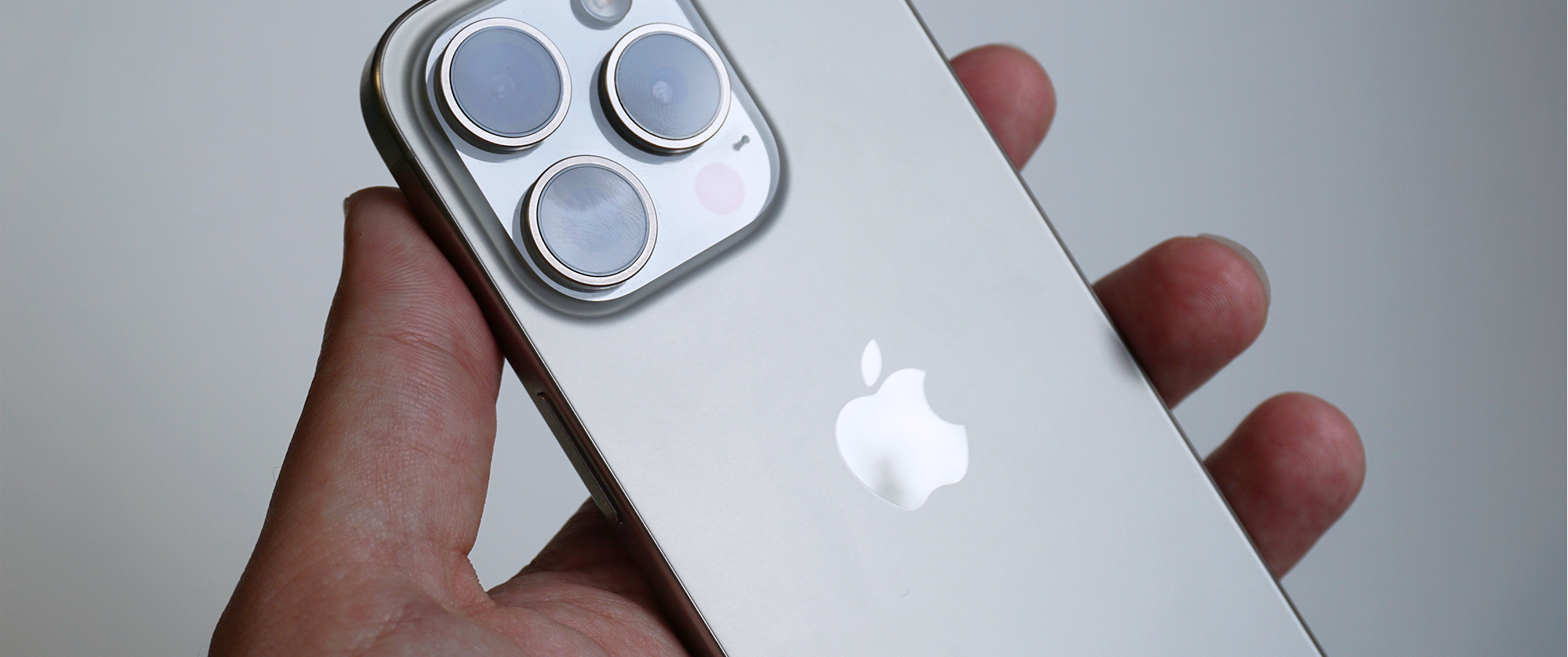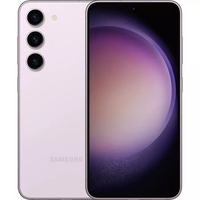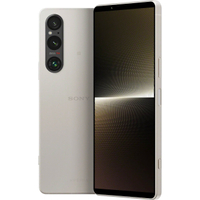TechRadar Verdict
With new materials, a freshened and softer design, USB-C, the wonderful Action button, and a wildly powerful mobile chipset, the iPhone 15 Pro is an uncompromising flagship. Or at least it would be if it's 3x optical zoom camera wasn't outshined by the iPhone 15 Pro Max's new 5x telephoto snapper.
Pros
- +
Beautiful titanium design
- +
Finally, USB-C connectivity
- +
All new A17 Pro chip
Cons
- -
Niche camera upgrades
- -
No change to battery longevity or charging
- -
3x telephoto zoom no longer Apple's best
Why you can trust TechRadar
Editor's Note
• Original review date: September 2023
• Launch price: $999 / £999 / AU$1,849
• Target price now: $999 / £949 / AU$1,849
Update – March 2024: Argubaly the unsung hero of the iPhone 15 line, the iPhone 15 Pro remains one of the best phones on the market right now, especially if you're looking for a compact smartphone with high-end specs; handily outpacing newer rivals, like Samsung's Galaxy S24. While Pro iPhone pricing always takes a while to start falling, since launch it's started to creep down in the UK, while retailers in the US and Australia haven't yet budged on original pricing.
As for the user experience, Apple has since pushed out new features to iOS 17, especially in select markets like the EU, where sideloading is now on the table. Beyond these minor adjustments, however, the rest of this review remains as previously published.

iPhone 15 Pro: Two-minute review
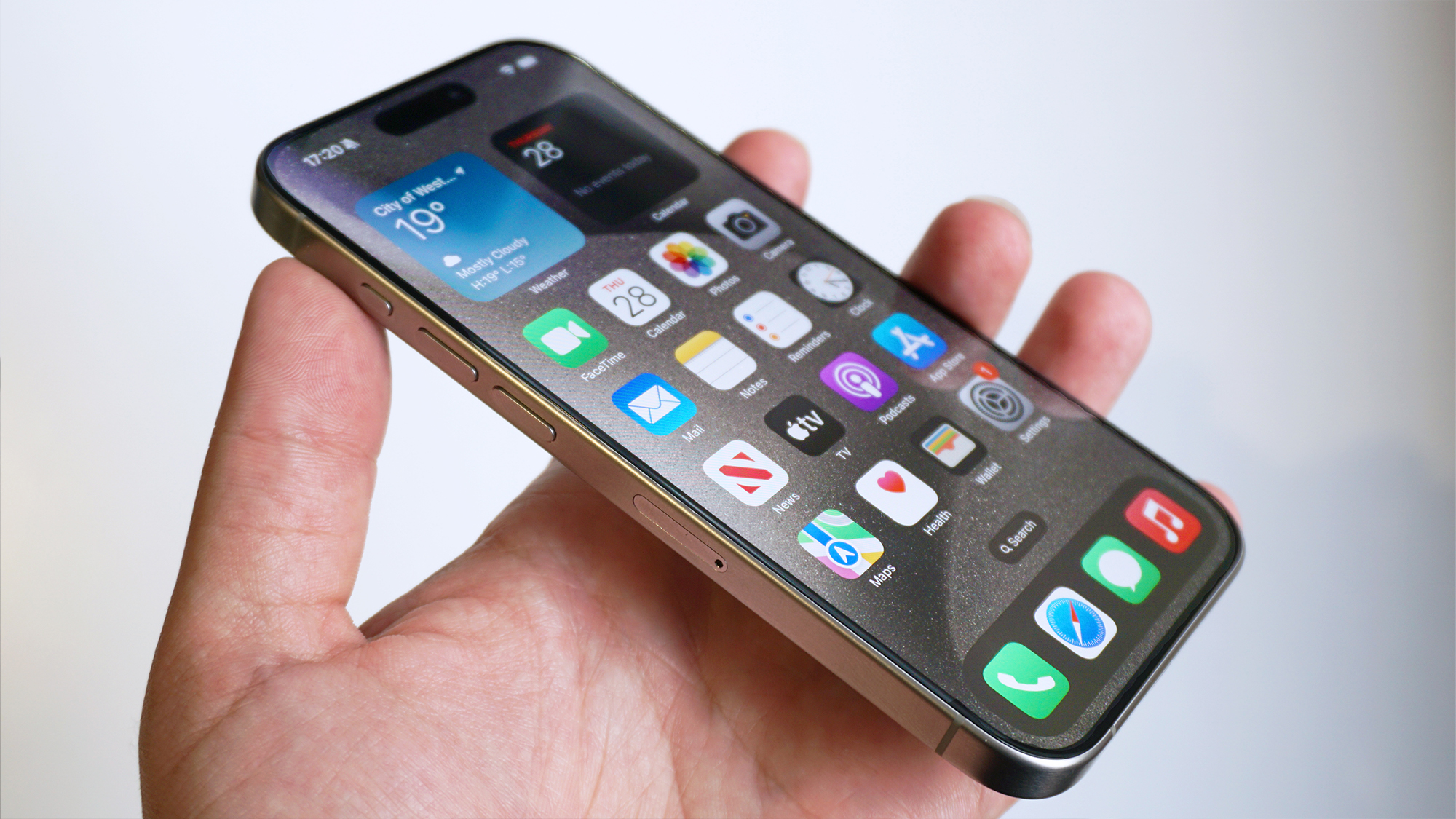
Apple's latest crop of iPhones bear familiar titles, but this year, its new Pro and Pro Max devices are separated by more than just display size and battery capacity.
By lacking the 5x optical zoom telephoto camera of its larger sibling (3x optical zoom remains), the iPhone 15 Pro may seem like Apple's 'semi-flagship' iPhone of 2023. But dubbing it that would be a disservice to this premium powerhouse, which isn't otherwise wanting for other flagship specs or features.
Indeed, the gap between the iPhone 15 Pro and the standard iPhone 15 remains significant. Every model in this year's iPhone lineup has benefited from a design refresh that splits the difference between the curvy iPhone 11 and last year's iPhone 14 Pro. But the iPhone 15 Pro gets a titanium frame that's serves up a higher strength-to-weight ratio than the stainless steel you'll find on other iPhone 15 models (and every iPhone that's come before).
USB-C ports now feature across the board, too, and Apple's newest Pro models also boast an Apple Watch Ultra-style Action button in place of the traditional mute switch (a simple but surprisingly useful substitution). This new toggle can trigger various actions, offering a fast way to access your favorite apps and tools without swiping through home screens and menus.
Other upgrades to the iPhone 15 Pro include the new A17 Pro chipset, which proves to be at the top of the class, as well as facilitating significantly faster data transfer speeds, which ensure that Apple's latest 6.1-inch wonder dethrones its predecessor on our list of the best phones money can buy.
Even without the 15 Pro Max's 5x telephoto, the 15 Pro still serves up an excellent camera experience that's reliable and now comes bolstered by upgrades aimed at professional content creators, with recording at up to 4K/60fps in ProRes to external storage and capture in Log, with ACES compliance.
(We also have a full iPhone 15 review, iPhone 15 Pro Max review, and an iPhone 15 Plus review if you want the complete iPhone 15 picture)
iPhone 15 Pro review: Price and availability
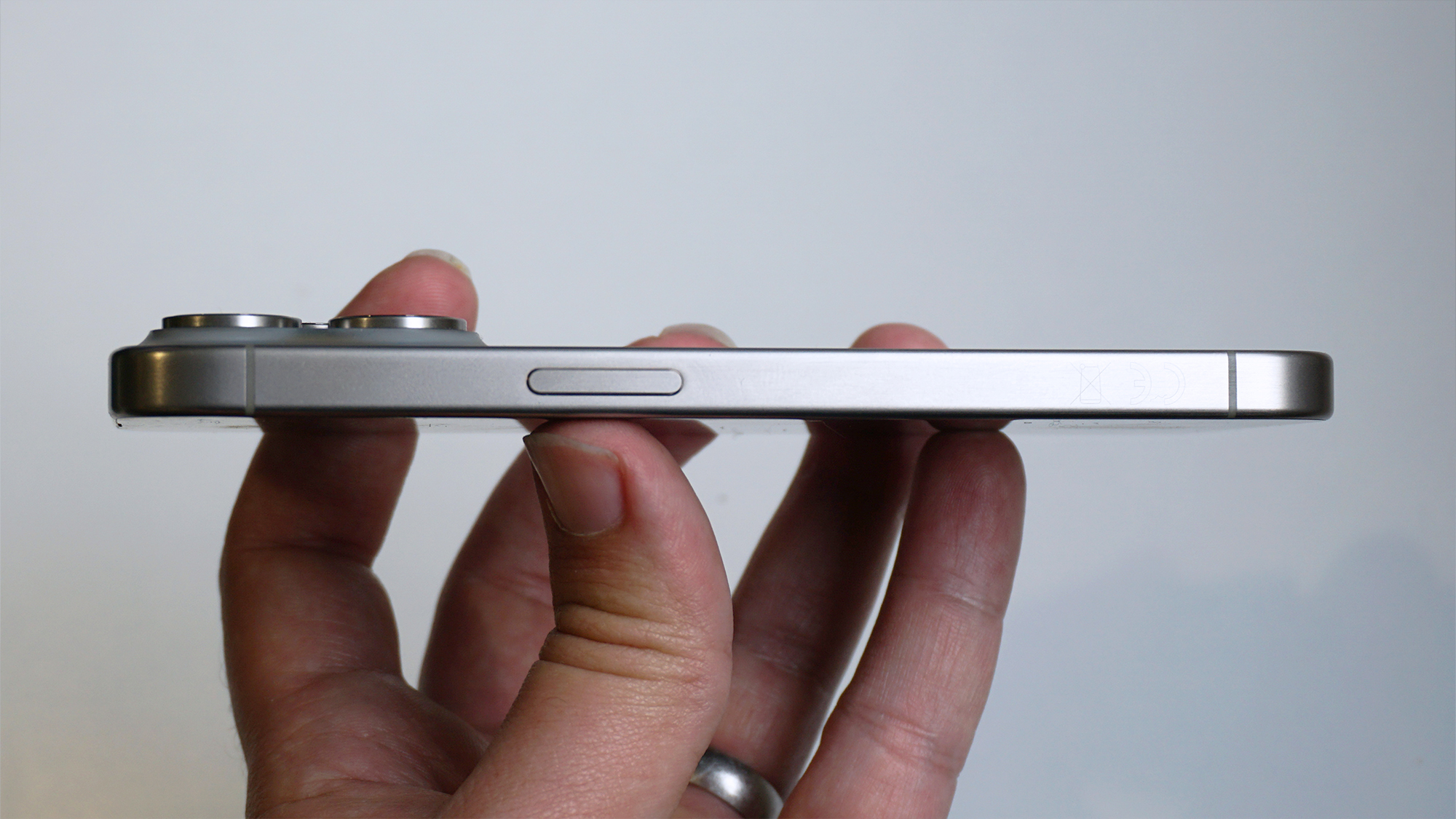
- Same US pricing as iPhone 14 Pro
- Cheaper than predecessor in the UK
- Slightly pricier than predecessor in Australia
The iPhone 15 Pro was officially unveiled alongside the iPhone 15, iPhone 15 Plus, and iPhone 15 Pro Max at Apple’s September 2023 Event on Tuesday, September 12. Pre-orders started on Friday, September 15, with the all models starting to ship as of September 22.
The iPhone 15 Pro is available in four storage variants – 128GB, 256GB, 512GB, and 1TB. No other iPhone 15 has this much storage variety; even the Pro Max dropped the 128GB option, which makes the entry price for that model about $100 more expensive year-on-year.
| Storage | US price | UK price | AU price |
| 128GB | $999 | £999 | AU$1,849 |
| 256GB | $1,099 | £1,099 | AU$2,049 |
| 512GB | $1,299 | £1,299 | AU$2,399 |
| 1TB | $1,499 | £1,499 | AU$2,749 |
In the US, the iPhone 15 Pro starts at $999 (for the 128GB version), $1,099 for the 256GB option, $1,299 for the 512GB tier and $1,499 for the top 1TB capacity model – the same pricing as the 14 Pro sported one year prior.
After a painful price hike last year, UK pricing has thankfully dropped back down slightly, mirroring the US prices numerically; with the four storage variants costing £999, £1,099, £1,299 and £1,499 respectively. Australian pricing is, unfortunately a little higher this year, at AU$1,849, AU$2,049, AU$2,399 and AU$2,749. As to why the pricing outside of the US fluctuates so much, Apple explained to me that the variation in each year's iPhone outside of the US is directly reflective of exchange rates on foreign currencies, relative to US pricing.
For comparison with its most prominent rival – the Samsung Galaxy S23 line – the 15 Pro starts at $200 more than a baseline 128GB 6.1-inch display-toting Galaxy S23. Meanwhile, the base Galaxy S23 Plus model – which sports a 6.6-inch display and double the base storage of the entry iPhone 15 Pro (at 256GB) – starts at the same $999 in the US as the iPhone. The top-tier iPhone 15 Pro Max-rivalling Galaxy S23 Ultra costs from $1,199, which like the Pro Max starts 256GB of storage.
- Value score: 3.5 / 5
iPhone 15 Pro review: Specs
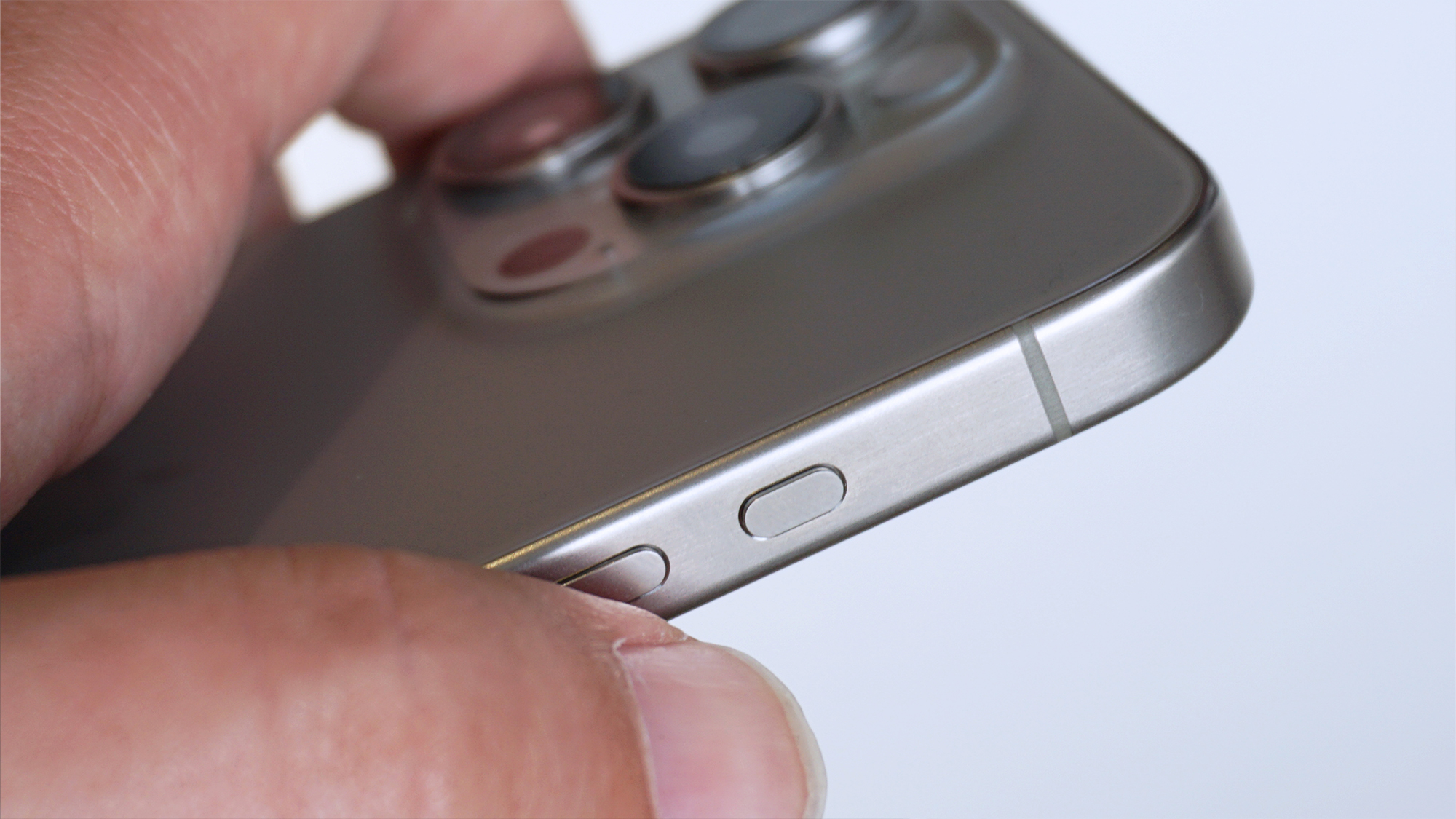
Check out the iPhone 15 Pro's full specs below:
| Header Cell - Column 1 | |
|---|---|
| Dimensions: | 146.6 mm x 70.6 mm x 8.25mm |
| Weight: | 187g |
| OS: | iOS 17 |
| Screen size: | 6.1 inches |
| Resolution: | 2556 x 1179 pixels |
| Chipset: | Apple A17 Pro |
| RAM | 8GB |
| Storage: | 128GB, 256GB, 512GB, 1TB |
| Rear Cameras: | 48MP wide, 12MP ultra-wide, 12MP telephoto w/ 3x optical zoom |
| Front Camera: | 12MP |
iPhone 15 Pro review: Design
- Titanium frame lowers weight and improves comfort
- USB-C: bad for Lightning accessory owners but otherwise welcome
- Action button is a powerful new hardware addition
- Class-leading IP68 dust & water resistance
Aesthetically speaking, the iPhone 14 Pro was a near-replica of the iPhone 13 Pro. However, Apple has given the Pro line's most recognizable design elements (by its own standards, at least) a significant reworking for 2023; for reasons both in and out of its control.
When it comes to phones, just a millimeter here and a degree there can make a notable difference to how a phone feels and that's especially true with the alterations made across the 15 series. The most obvious visual change is the burnishing away of the previous generations' sharp edges, meaning the 15 Pro has a notably different (and more pleasant) feel.
The iPhone 15 Pro (as with the rest of the line) still sports flat sides that wrap around the edge of the phone, but there's now subtle rounding where there was once an almost zero-degree radius. More importantly, the Pro line features a new titanium frame that makes the iPhone 15 Pro significantly lighter than its stainless steel predecessor (Apple’s latest flagship weighs 187g, whereas the iPhone 14 Pro clocks in at 206g) while retaining a decent degree of strength.
Apple's Pro iPhones have always been heavy for their screen size, so this 19-gram reduction across both the iPhone 15 Pro and 15 Pro Max is revelatory for the series. The benefits are arguably more prominent on the Pro Max. But considering all that Apple's managed to fit inside the 15 Pro, adding a weight reduction (making this the lightest Pro model ever) on top is nonetheless welcome.
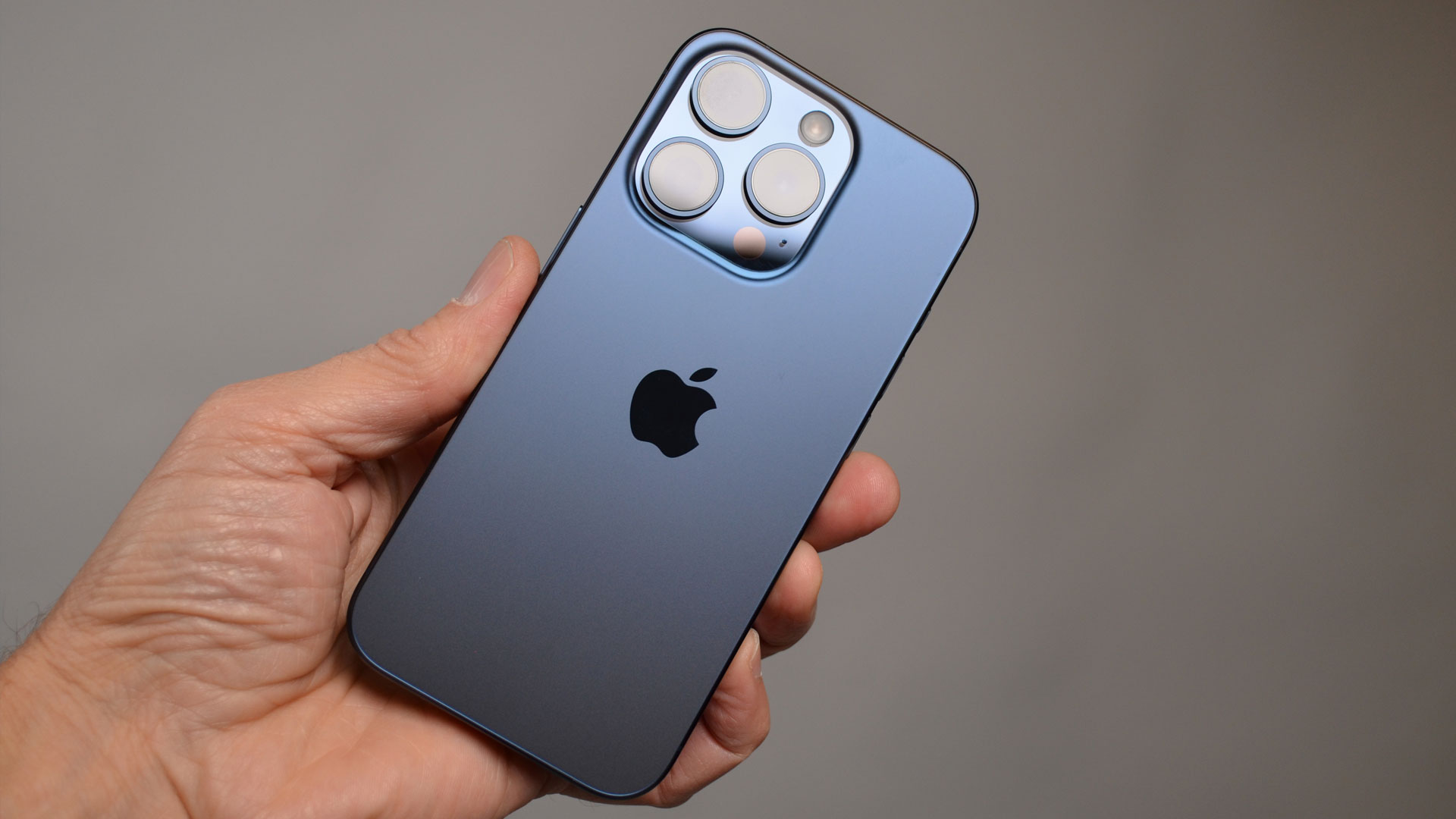
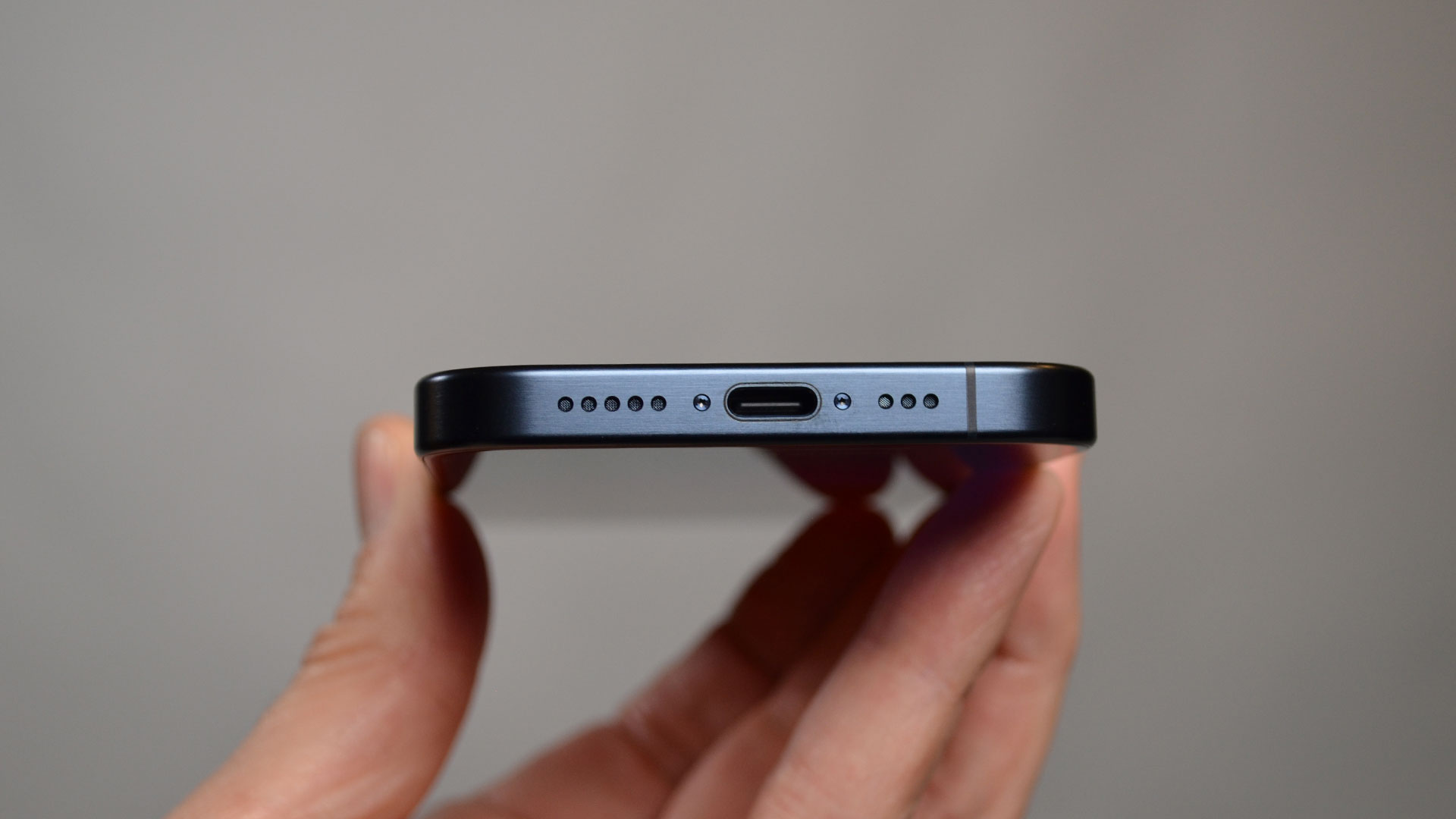
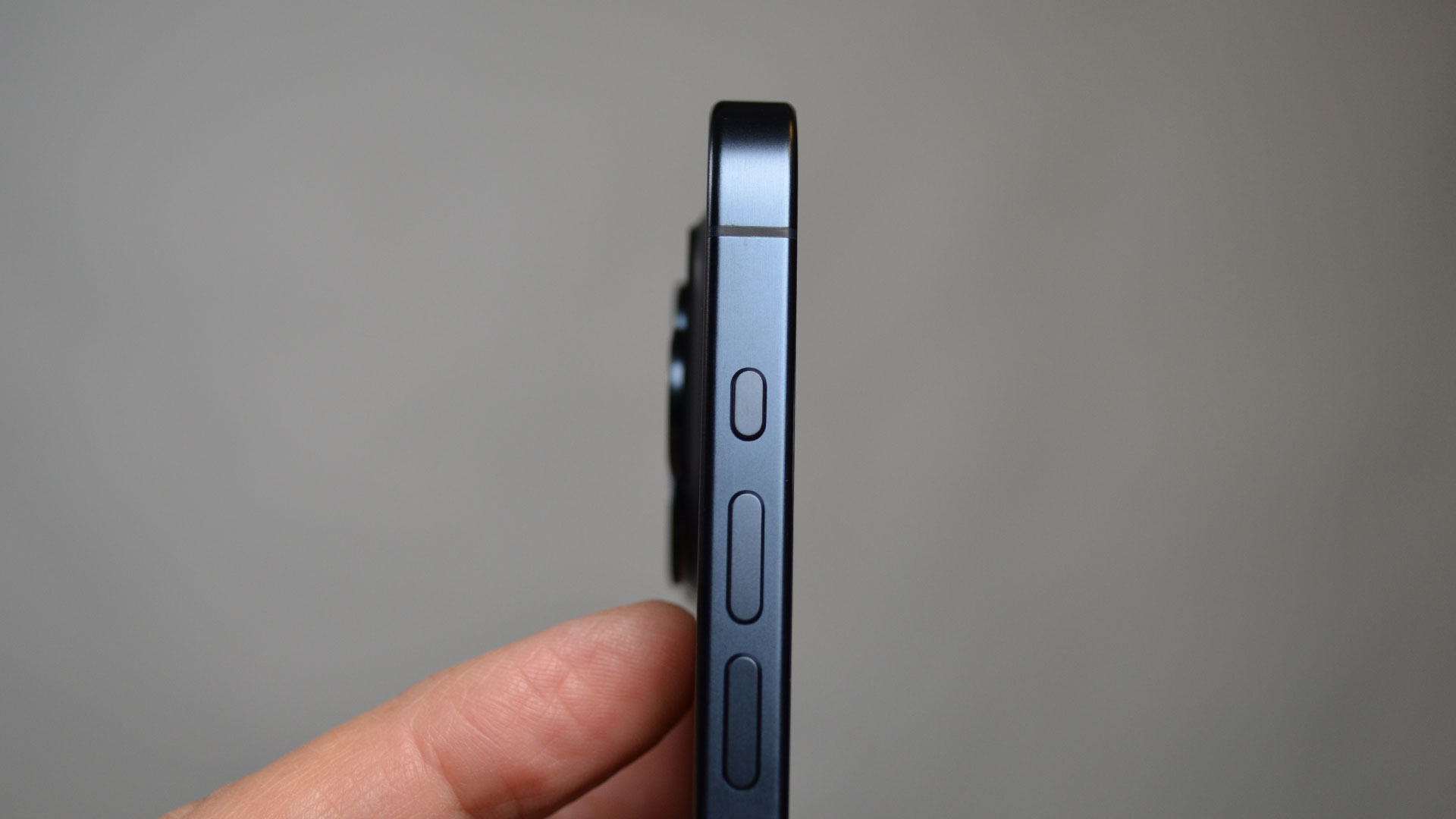
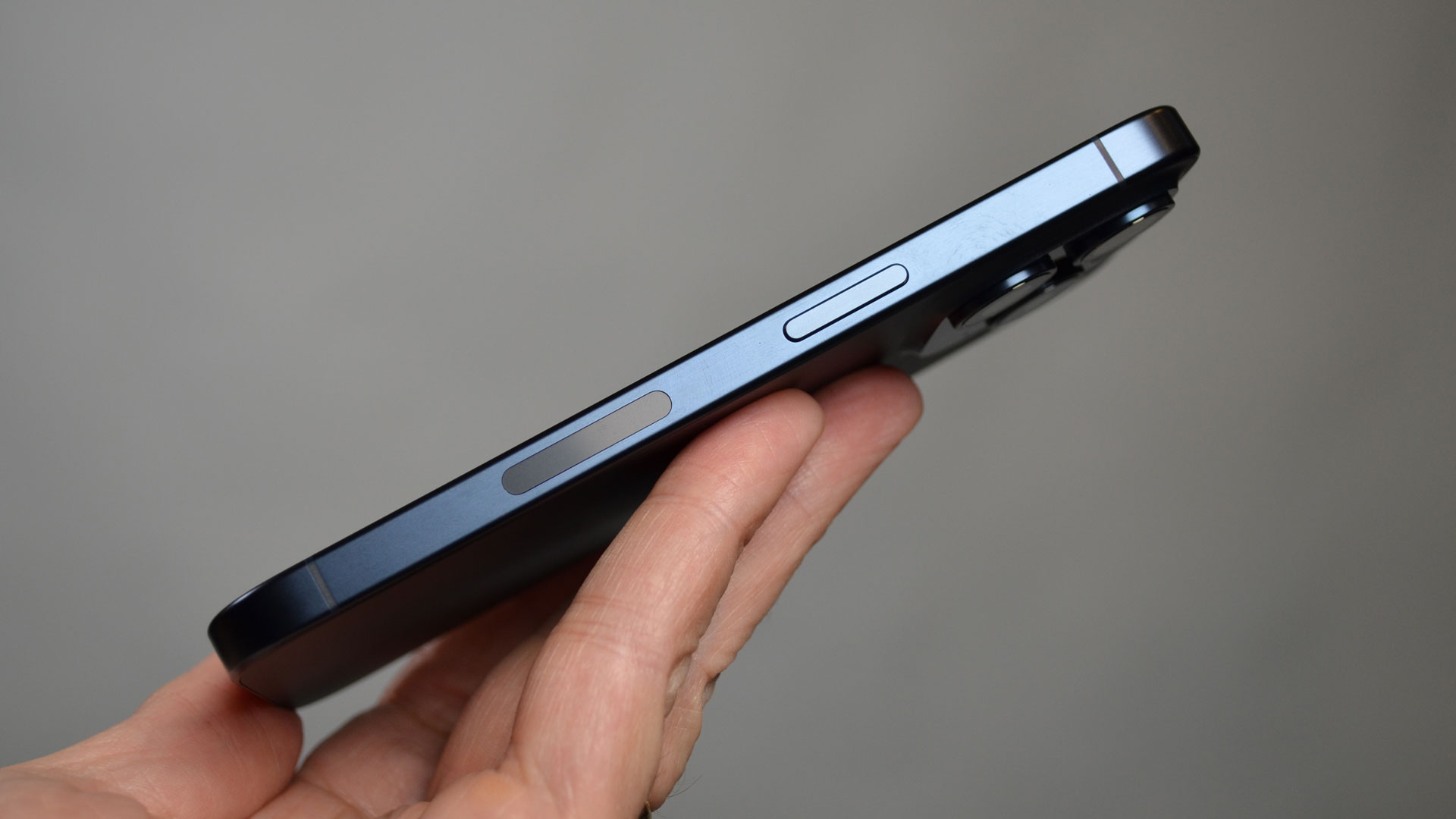
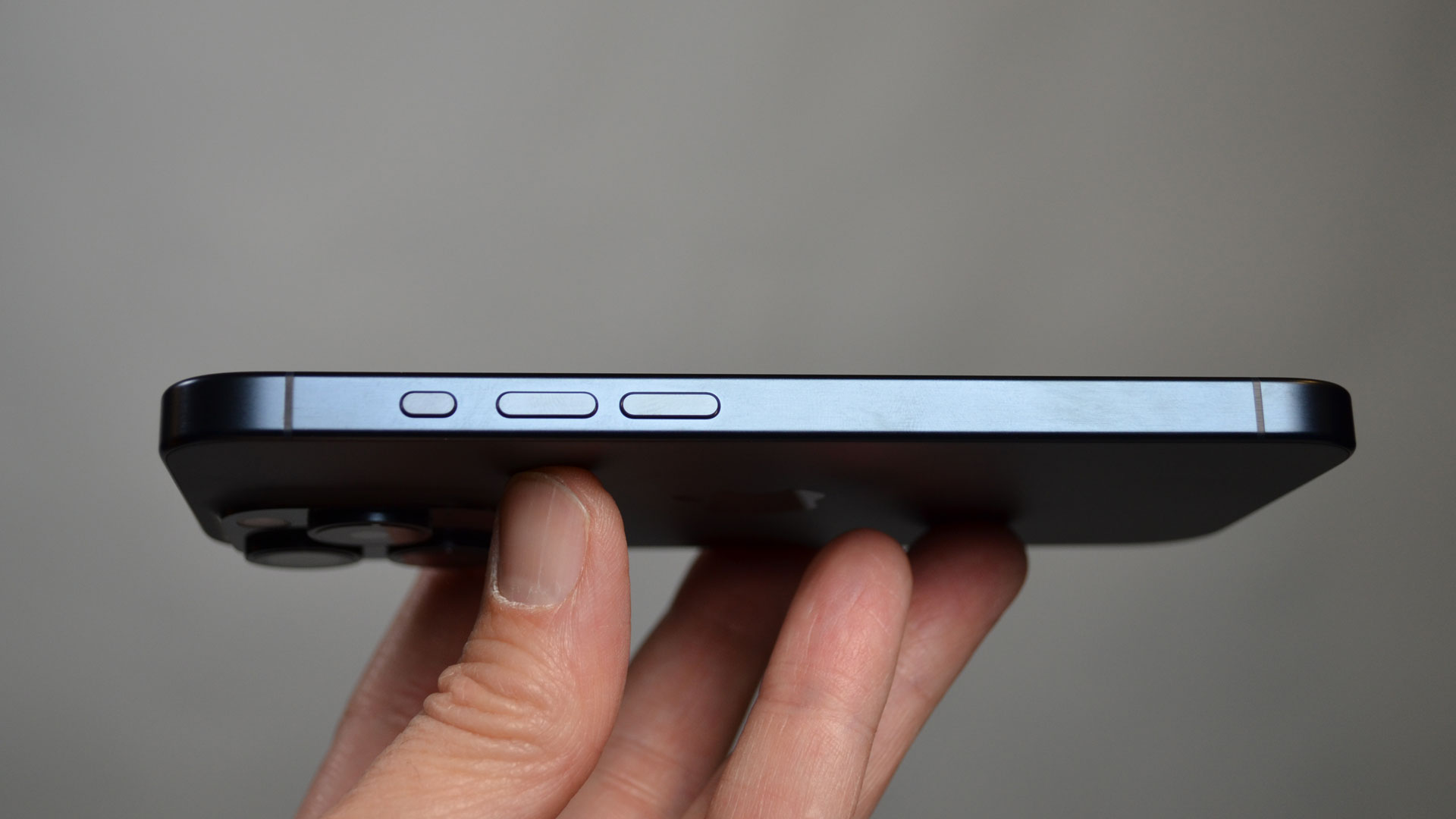
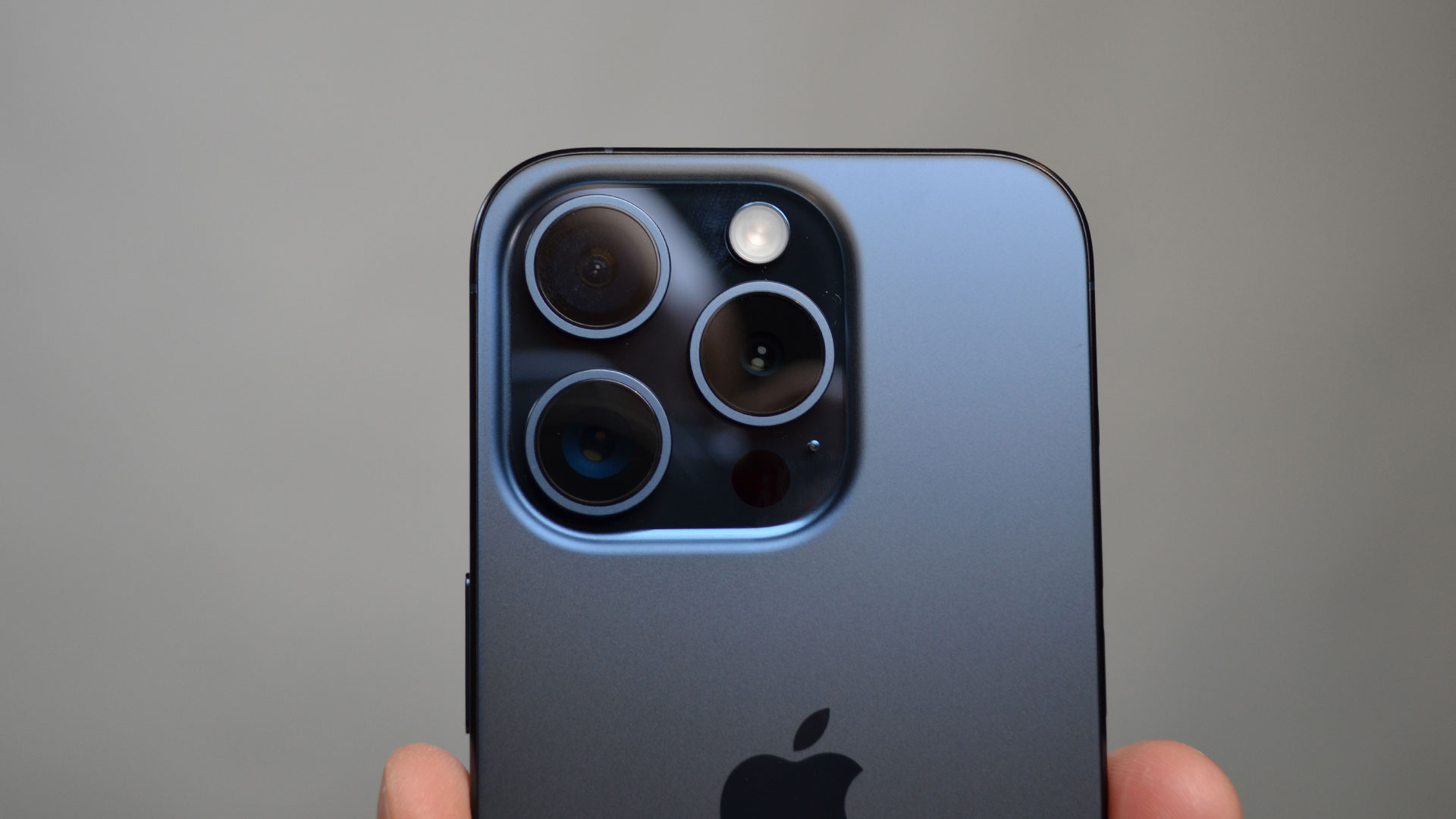
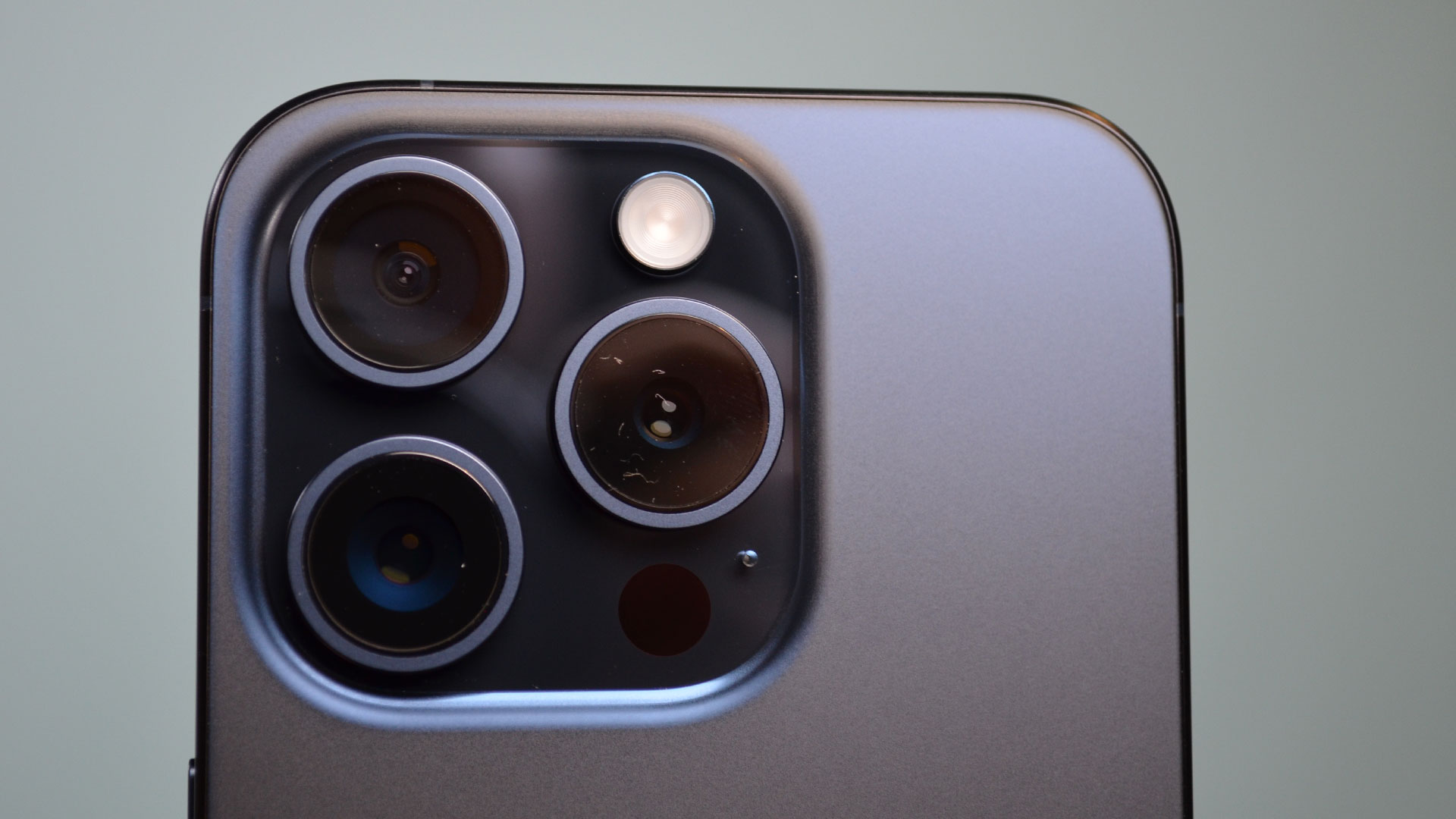
Another big change has to do with the phone's 6.1-inch display. The bezels running around its boundary are now uniformly thinner (compared to the 14 Pro), which paired with that titanium alloy frame, mean the height and width of this generation's Pro have also been reduced too. All this helps with the phone's feel, pocketability and ease of use. Apple’s dream of a bezel-less iPhone is inching ever-closer, it seems.
Both the Dynamic Island and rear diffused glass panel return from last year’s device, with the latter now more easily replaceable, greatly reducing the cost of repair compared to the previous generation (in the US, what would have cost $499 to replace, now costs a comparatively minor $199).
Beyond these primarily visual, arguably superficial design upgrades, Apple has also introduced a handful of updates that dramatically alter the functionality of the iPhone 15 Pro versus its predecessor.
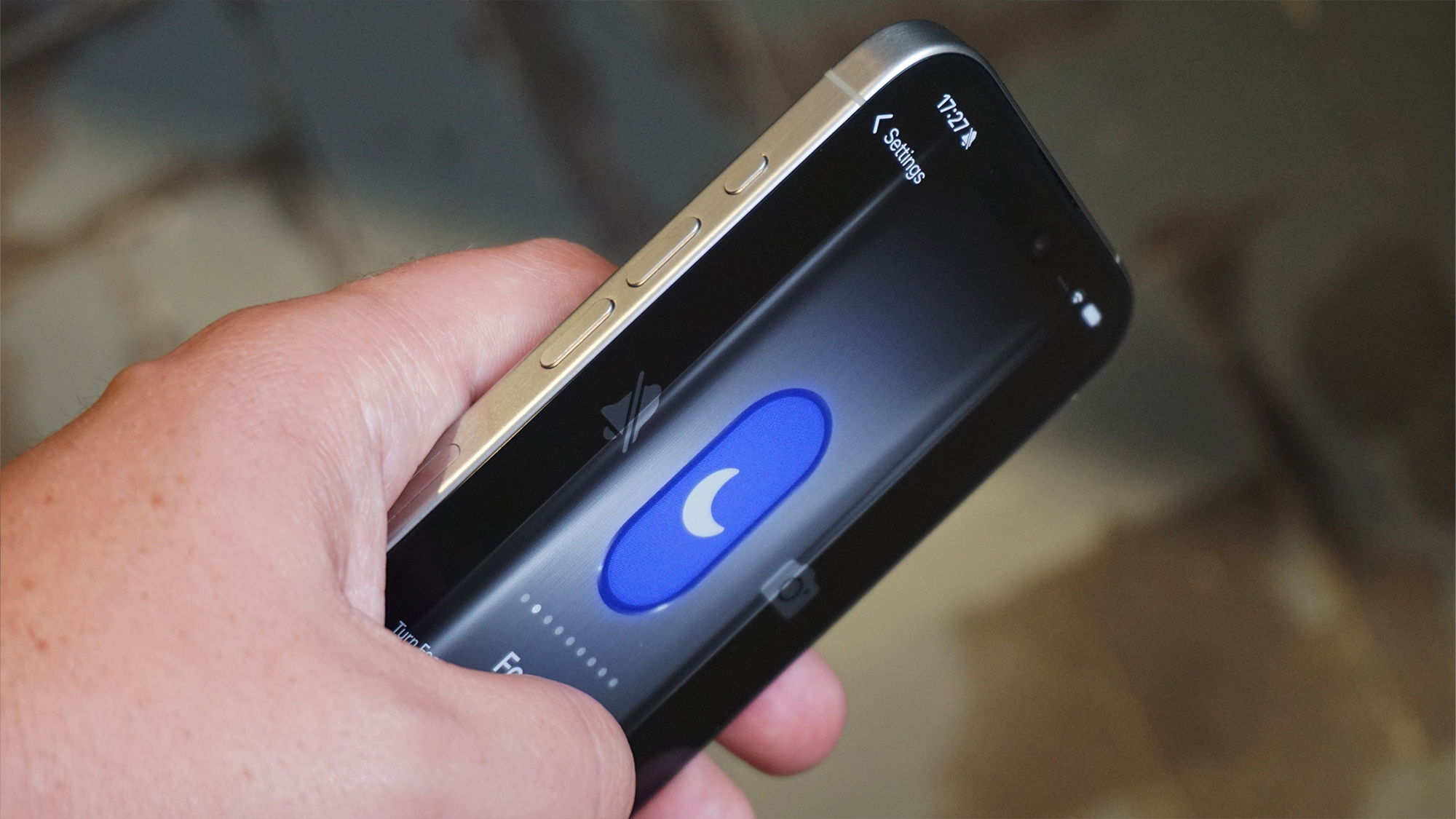
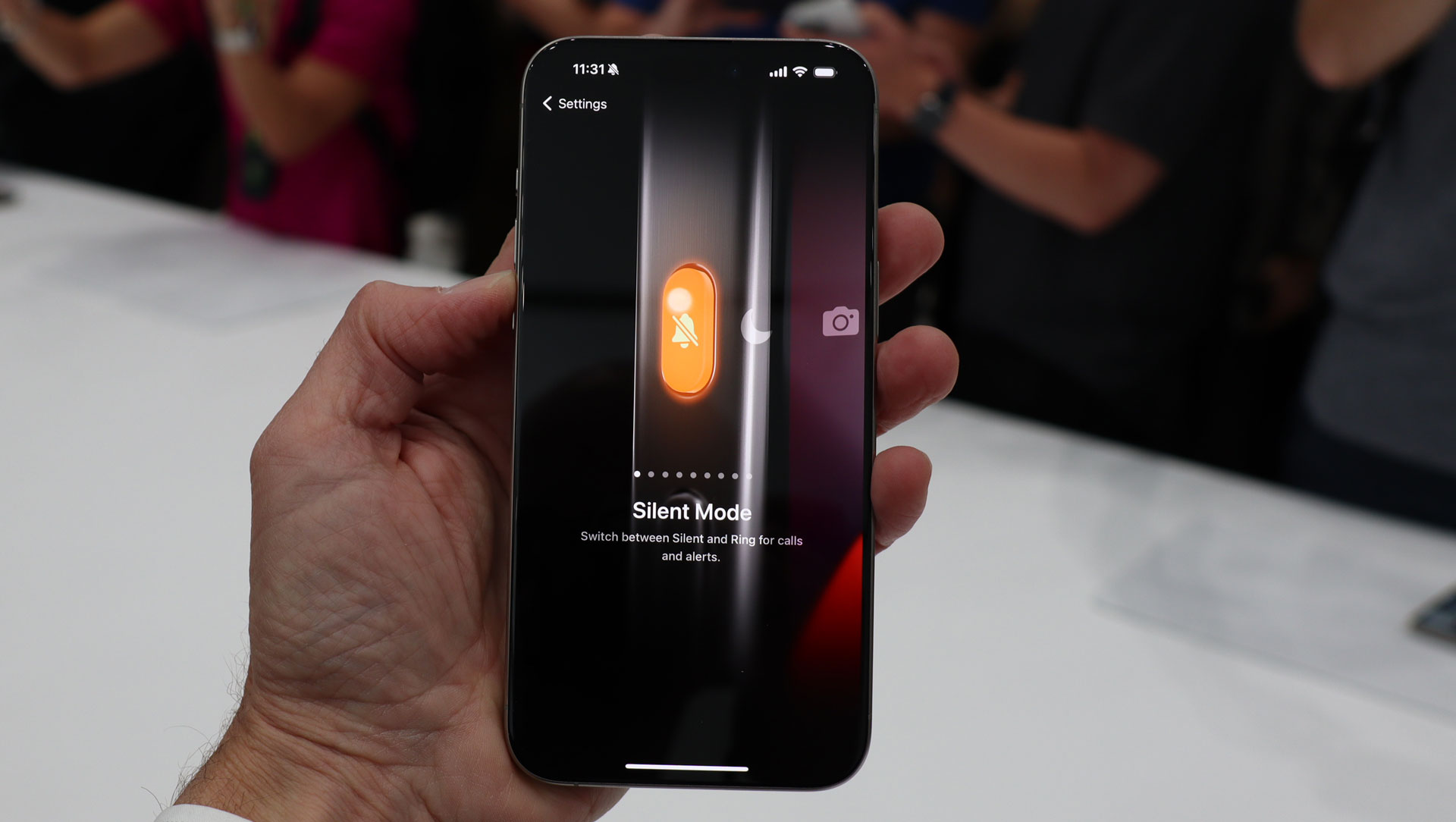
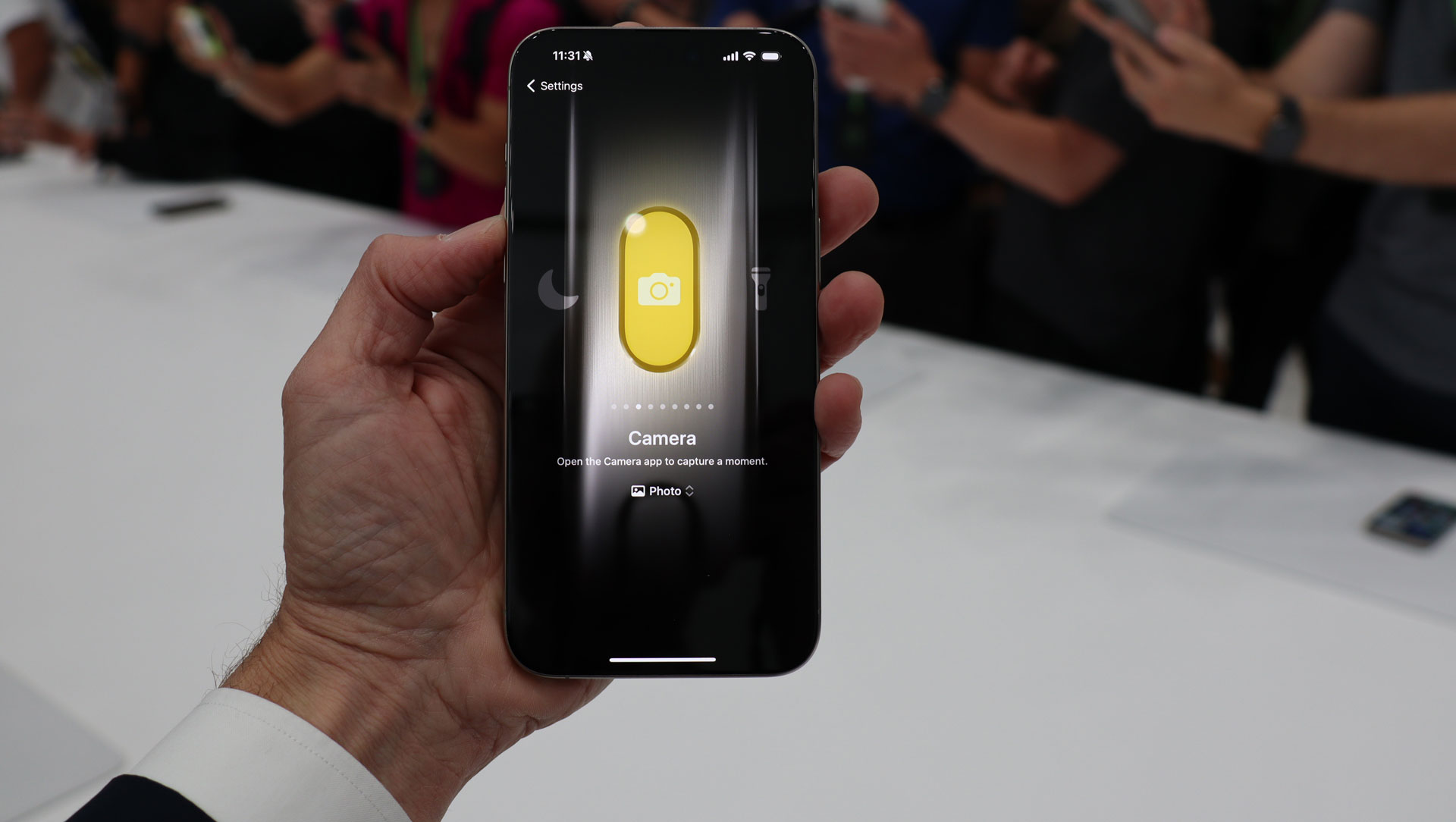
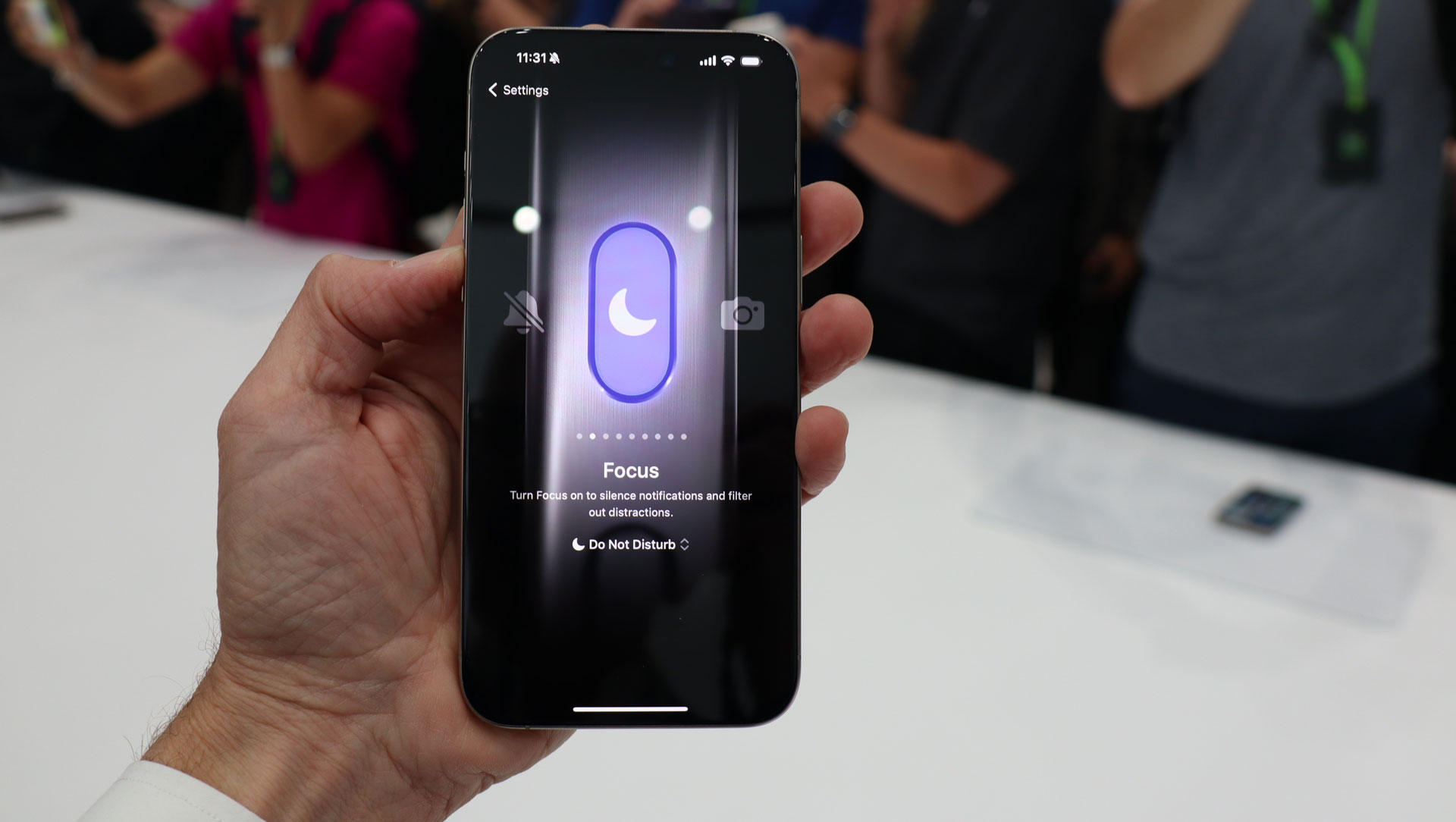
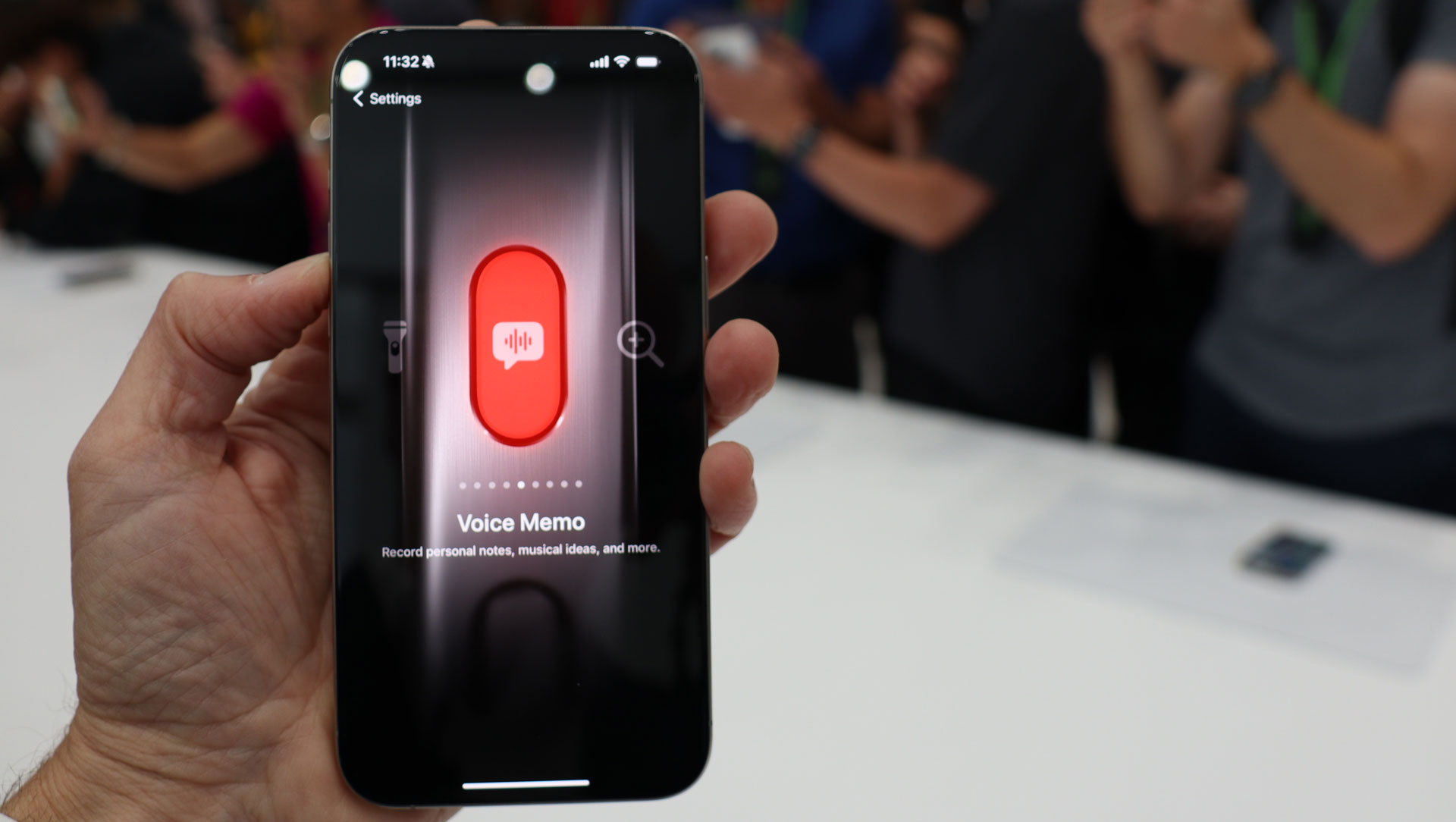
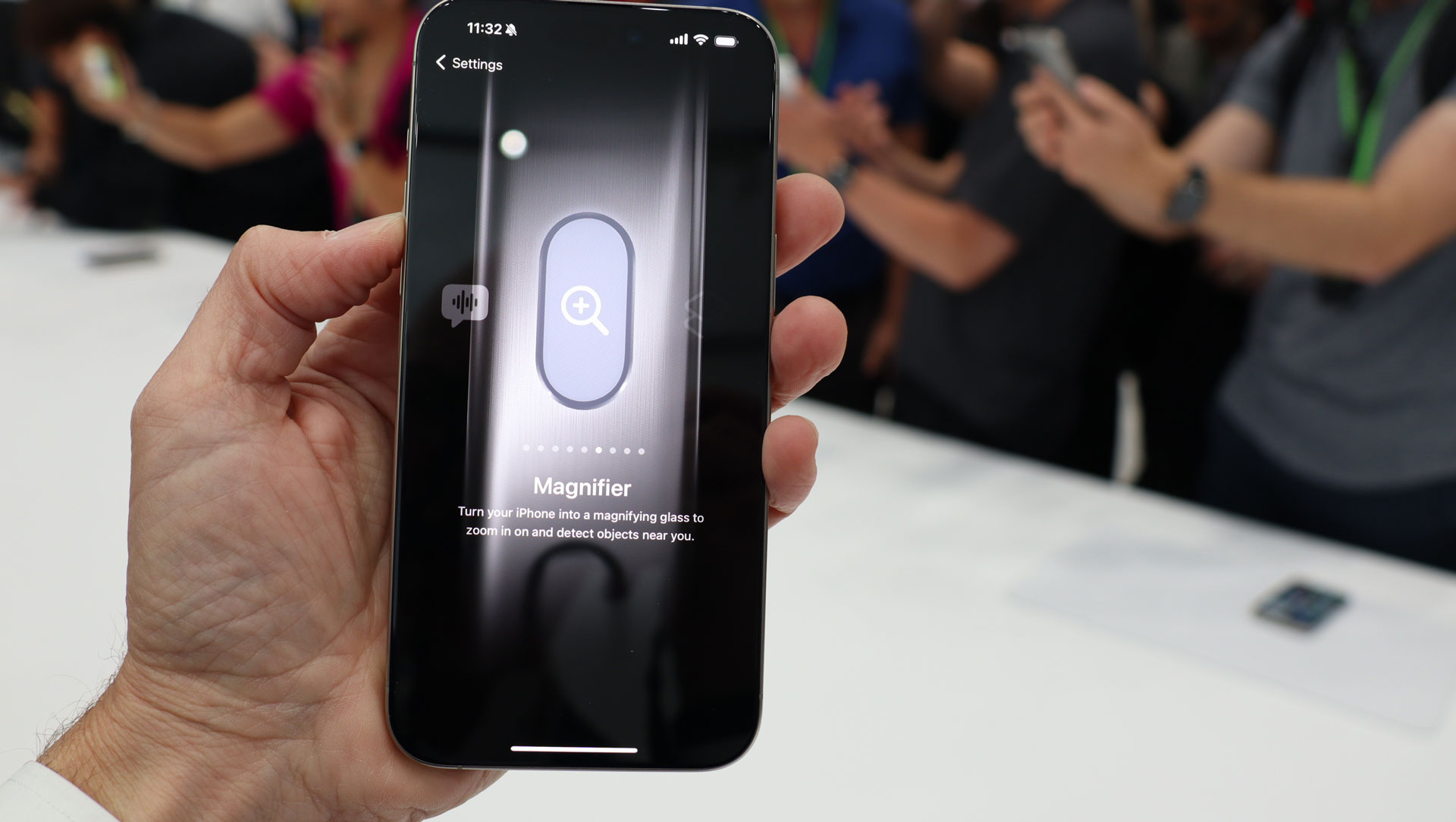

The first is an Apple Watch Ultra-style Action button, which arrives in place of the traditional, physical mute switch on this year's Pro models only. This customizable button lets you trigger up to nine different actions.
But before I dive into all that, let's just take a moment to pay our respects to the iPhone's ubiquitous silent/ring switch, which now only remains on the standard iPhone 15 and iPhone 15 Plus, and will likely fade from the company's phones entirely come the iPhone 16 series' launch next year; looks like it's up to you now OnePlus...
The switch to the Action button does change how you check whether the phone is set to ring or silent, with an on-screen indicator and haptic feedback replacing the glanceable design of old. The Action button is so much more than that though. The offer of a customizable hardware button seems uncharacteristic of Apple but I'm not one to complain.
If you're happy switching between ring and silent via on-screen controls, the button can instead serve as a way to enter predefined Focus modes, jump straight into the camera app, turn on the flashlight, record a voice memo, initiate translate (coming post launch via software update), open the magnifier, trigger a chosen accessibility shortcut. Or perhaps most powerful of all, fire off any shortcut of your own creation from Apple's Shortcut app; think smarthome routines, your favorite playlist, Shazam or opening any app of your choosing.
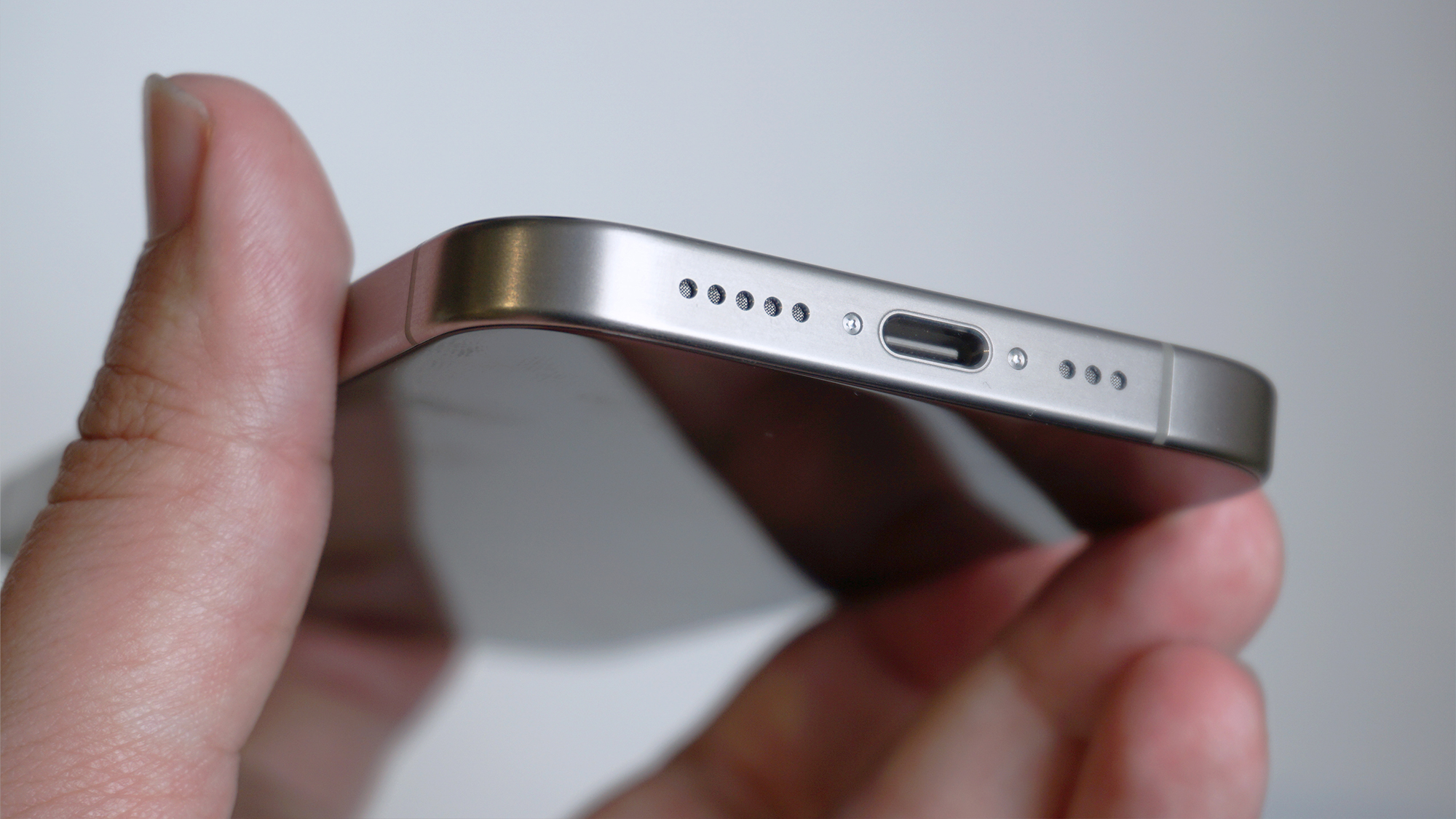
The second major change is a USB-C port, which replaces Apple’s proprietary Lightning port on every model in the iPhone 15 lineup. While I might be sentimental about the loss of the ring/silent switch, I welcome the long overdue jump to USB-C.
USB-C is the latest universal standard for the wired connection of smart devices. If you buy a smart device in 2023 – be it one of the best Android phones, best laptops, or best smart speakers – it’ll likely feature a pill-shaped reversible port to support USB-C charging and data transfer, and Apple has opted to adorn its latest crop of iPhones with these ports following a recent EU regulation.
As for how this transition from Lightning to USB-C affects the functionality of the iPhone 15 Pro, it doesn't impact charging speed, sadly, but does enable USB 3.2 Gen 2 data transfer speeds of up to 10Gbps. Imagine connecting the iPhone 15 Pro directly to your MacBook Pro, taking ProRes photos, and having them appear almost instantly on your Mac – this was a demo I saw first-hand at Apple's Battersea HQ and is one of those demos that seems purpose-built to show why this phone deserves its 'Pro' suffix.
For a more practical example, my face lit up when I realized I was able to plug the Pro directly into my car's USB-C adapter-laden aux cord to play tunes; a cable once explicitly reserved for my Android phones, as I was unwilling to buy a Lightning to 3.5mm adapter.
One cable to charge all your devices is obviously the dream. However, the iPhone 15 series falls foul of being the transitionary generation, which is to say the one that gets the blame for all the eWaste Apple has just created by rendering long-time iPhone users' assorted Lighting-laden accessories obsolete without the use of hard-to-come-by male Lightning to female USB-C adapter.
- Design score: 4.5 / 5
iPhone 15 Pro review: Display
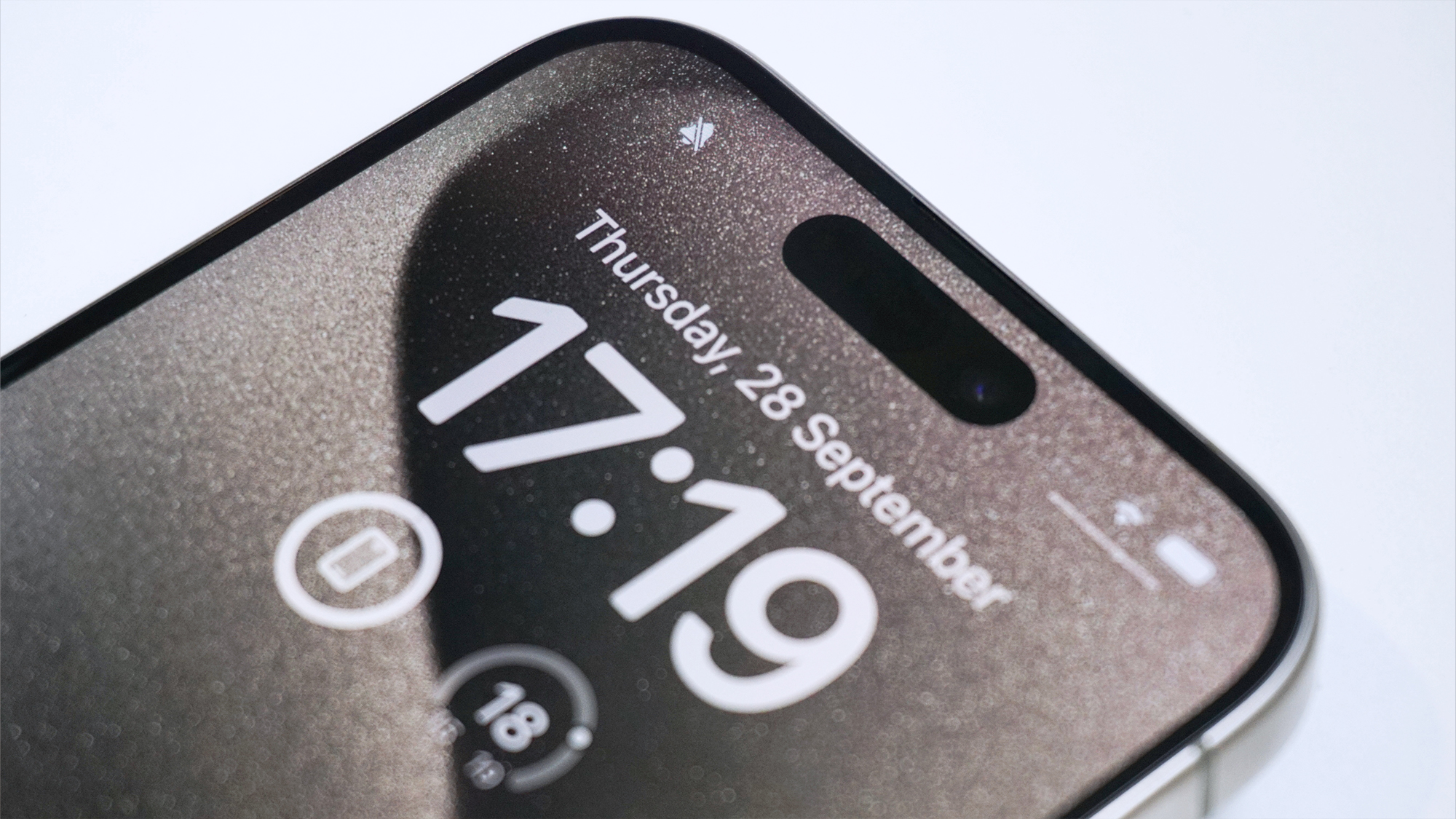
- 6.1-inch 'Retina Super XDR' OLED panel
- Protected by Ceramic Shield
- Dynamic Island (now on all iPhone models)
- Excellent always-on display implementation
The iPhone 15 Pro retains its predecessor’s excellent 6.1-inch Super Retina XDR OLED screen, with Apple’s ProMotion technology – which varies the refresh rate between 1Hz and 120Hz, depending on the content displayed – returning, too.
As mentioned, the Dynamic Island digital cutout is also present – though this notch is now a feature of every model in the lineup – and the iPhone 15 Pro’s bezels are largely non-existent. It's again protected by the company's Ceramic Shield: a transparent material containing ceramic crystals for extra protection (although previous experiences with the 14 Pro Max highlighted to me that the material's scratch resistance is nowhere near as impressive as its impact resistance).
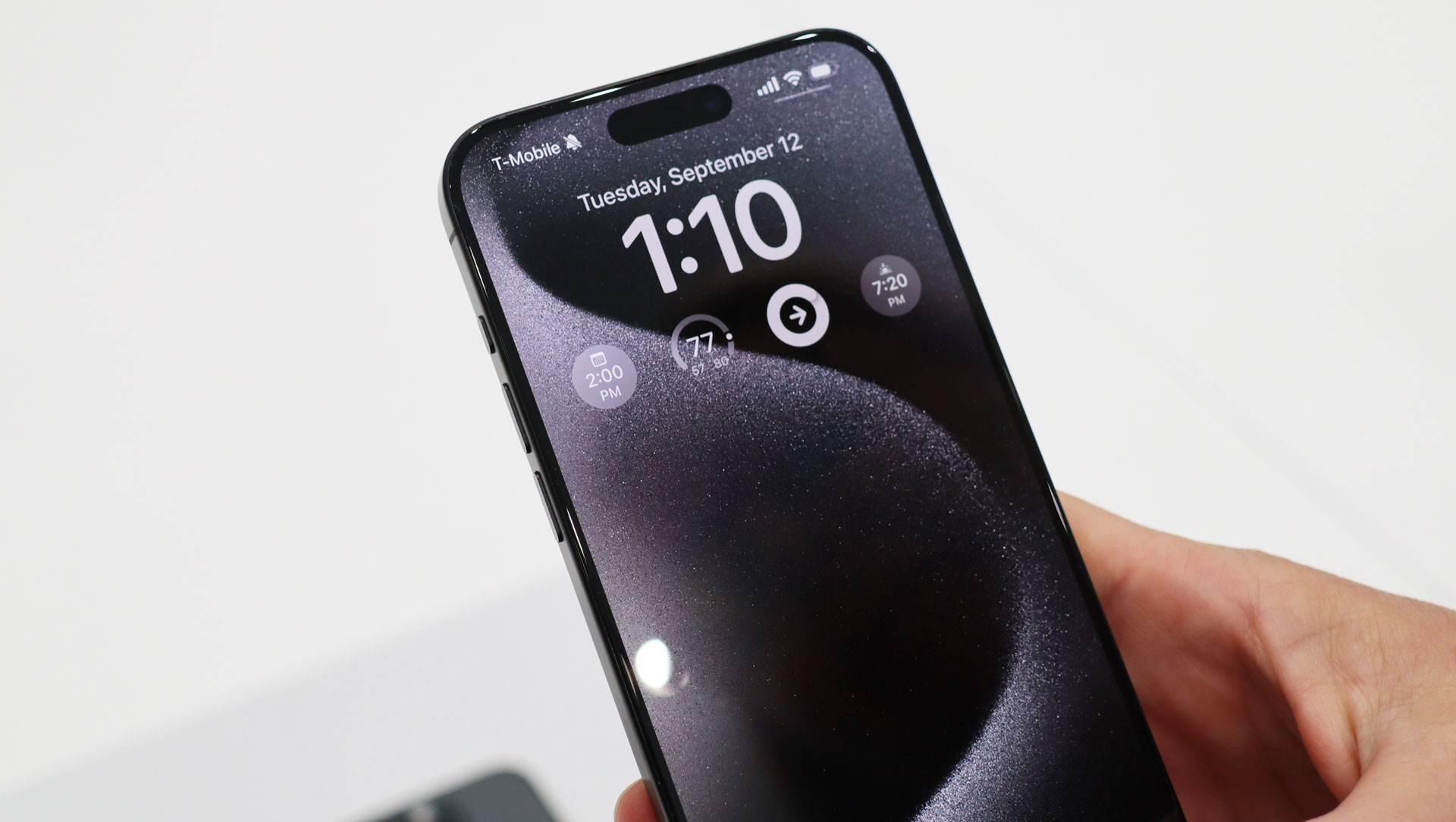
It is still a gorgeous and responsive screen (also bright, reaching a max 2,000 nits – like its predecessor). The tinier bezel instantly makes it a more immersive display too and I would say it only suffers when placed next to the larger and equally pretty iPhone 15 Pro Max's 6.7-inch Super Retina XDR display, especially if streaming media and gaming are high on your list of priorities with a new phone.
I also have to lend a hand to Apple once again for its excellent implementation of always-on display technology. Along with negligible impact on battery life, the 14 Pro and 15 Pro line are the only phones that serve up a full-screen always-on experience with as much depth and glanceable information. It's a feature I miss when moving to other devices; even those that offer their own implementation of an always-on display.
Put simply, this is the sort of display you’d expect to find strapped to one of the best phones on the market, and Apple hasn’t messed with a winning formula here and actually improved it just a tiny bit, thanks to those bezels.
- Display score: 5 / 5
iPhone 15 Pro review: Software
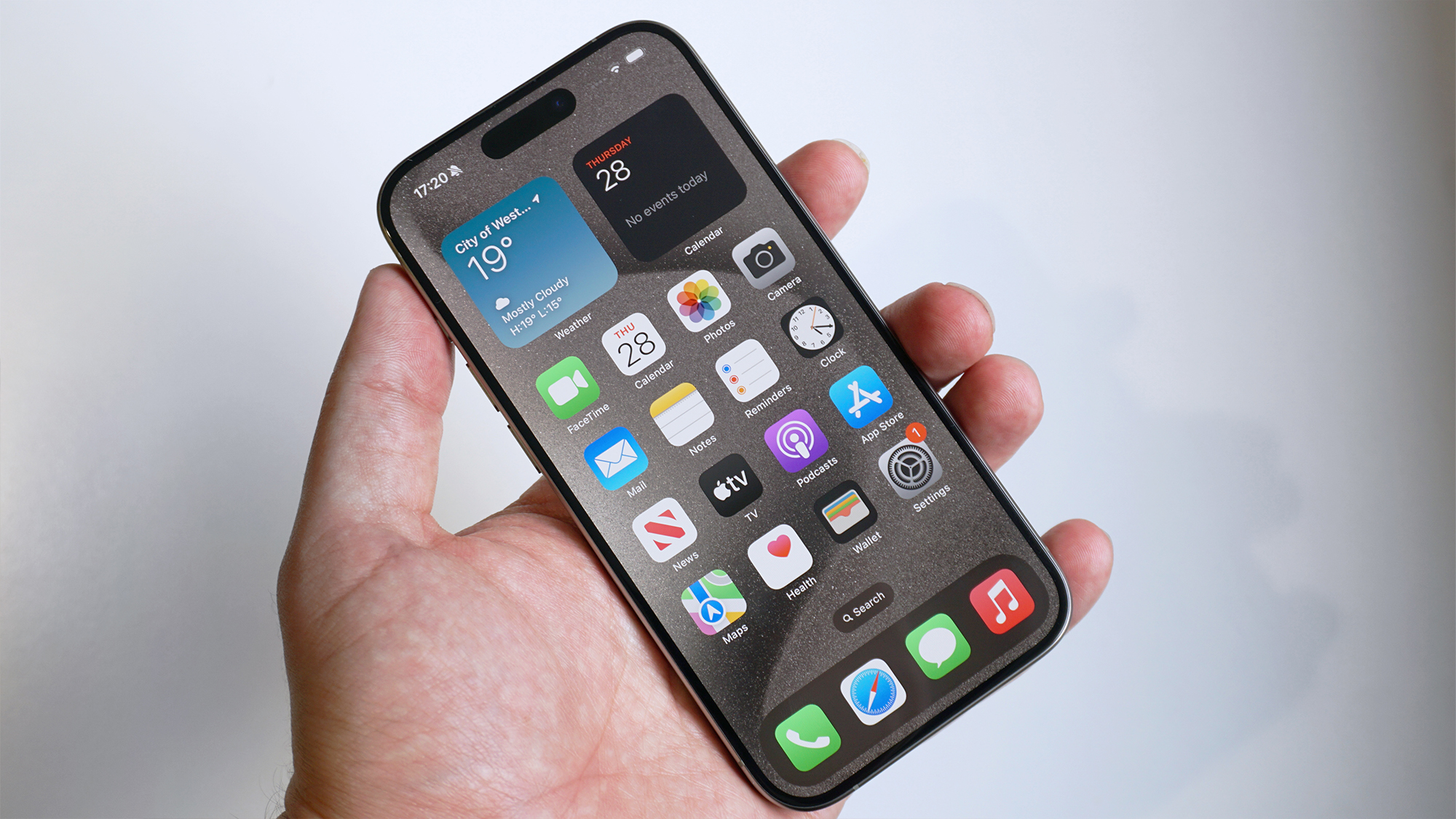
- Runs iOS 17 out the box
- New features include Check In, NameDrop and more
- At least five years of OS updates
With my colleague Philip Berne having already dug into the latest release of Apple's mobile software in his in-depth iOS 17 review, I'll give you the highlights based on the key additions the release brings to the table and which aspects felt particularly great during my time reviewing the iPhone 15 Pro.
Despite a cavalcade of new features, compared to iOS 16, iOS 17 doesn't feel like quite as seismic an update by comparison. Even so, the polish on new features – like Contact Posters and NameDrop – is undeniable and live up to Apple's 'it just works' slogan. Being able to pull in stickers from any media is a fun new touch and more functional quality-of-life improvements, like enhanced autocorrect, fresh ringtones and more responsive haptics aren't to be sniffed at either.
There are some other elements of the iPhone 15 Pro's specific fusion of software and hardware that are worth shouting about too. Take the slick interface Apple has included for the new Action button, for example; it's unlike anything else within iOS' settings and is both visually stimulating and clear in its intent. The Dynamic Island also continues to highlight Apple's ability to turn a physical limitation (the need for front-facing camera and FaceID components to be embedded in the display) into a selling point; I just wish Apple had done more with it natively, after a year on the market.
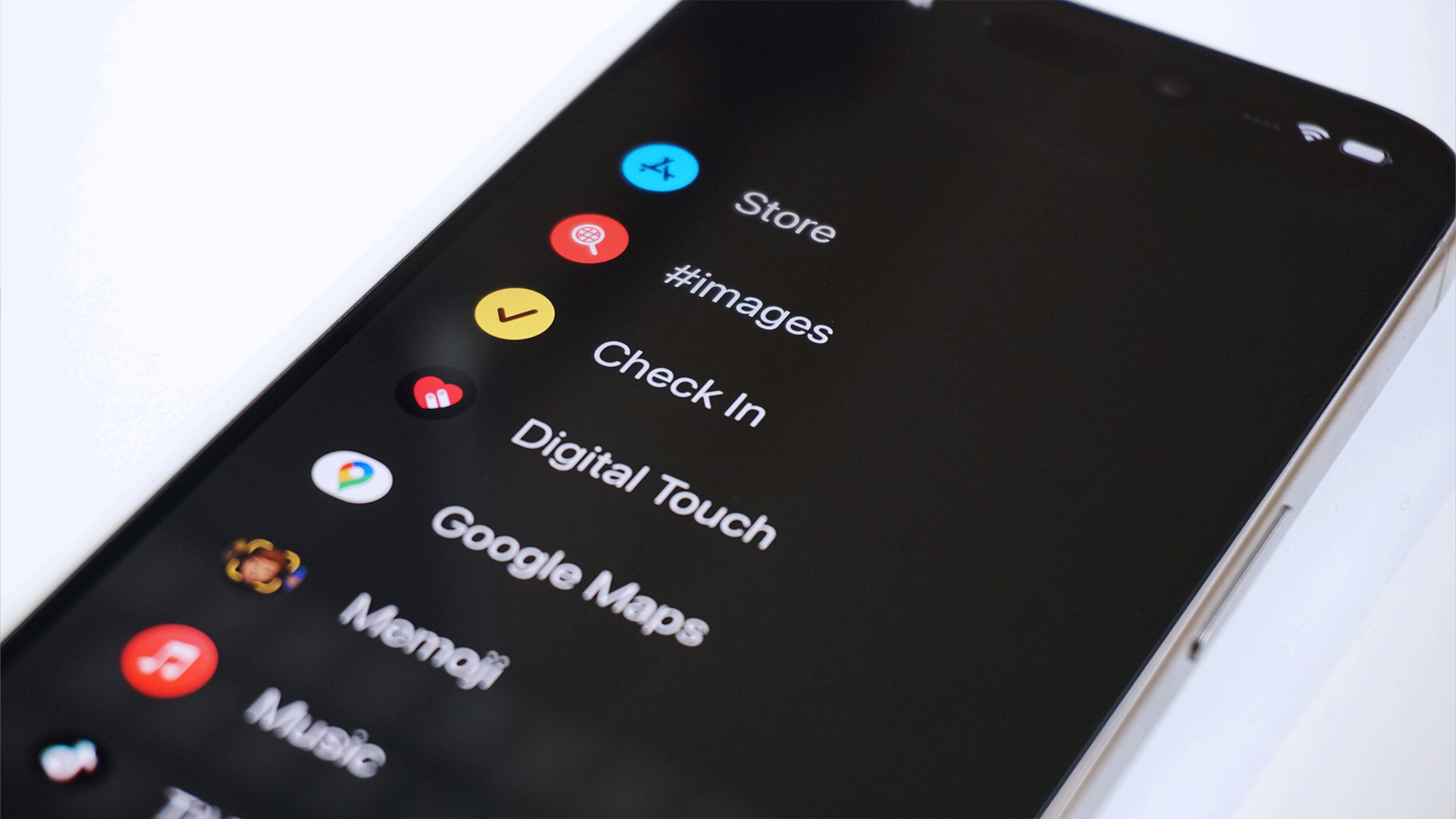
A special shout-out also has to go to StandBy, which adds yet more value to the Pro's already-excellent always-on display experience.
Then there's the software update roadmap to consider. Apple continues to lead the way, and while rivals like Samsung and OnePlus are catching up (and there's talk of Google's Pixel 8 series narrowing the gap too), the 15 Pro will likely get the same five years of OS updates (although Apple never confirms up front) that its predecessors have. And if you're lucky, that could stretch to six (or beyond, depending on how generous the company feels).
- Software score: 4.5 / 5
iPhone 15 Pro review: Cameras
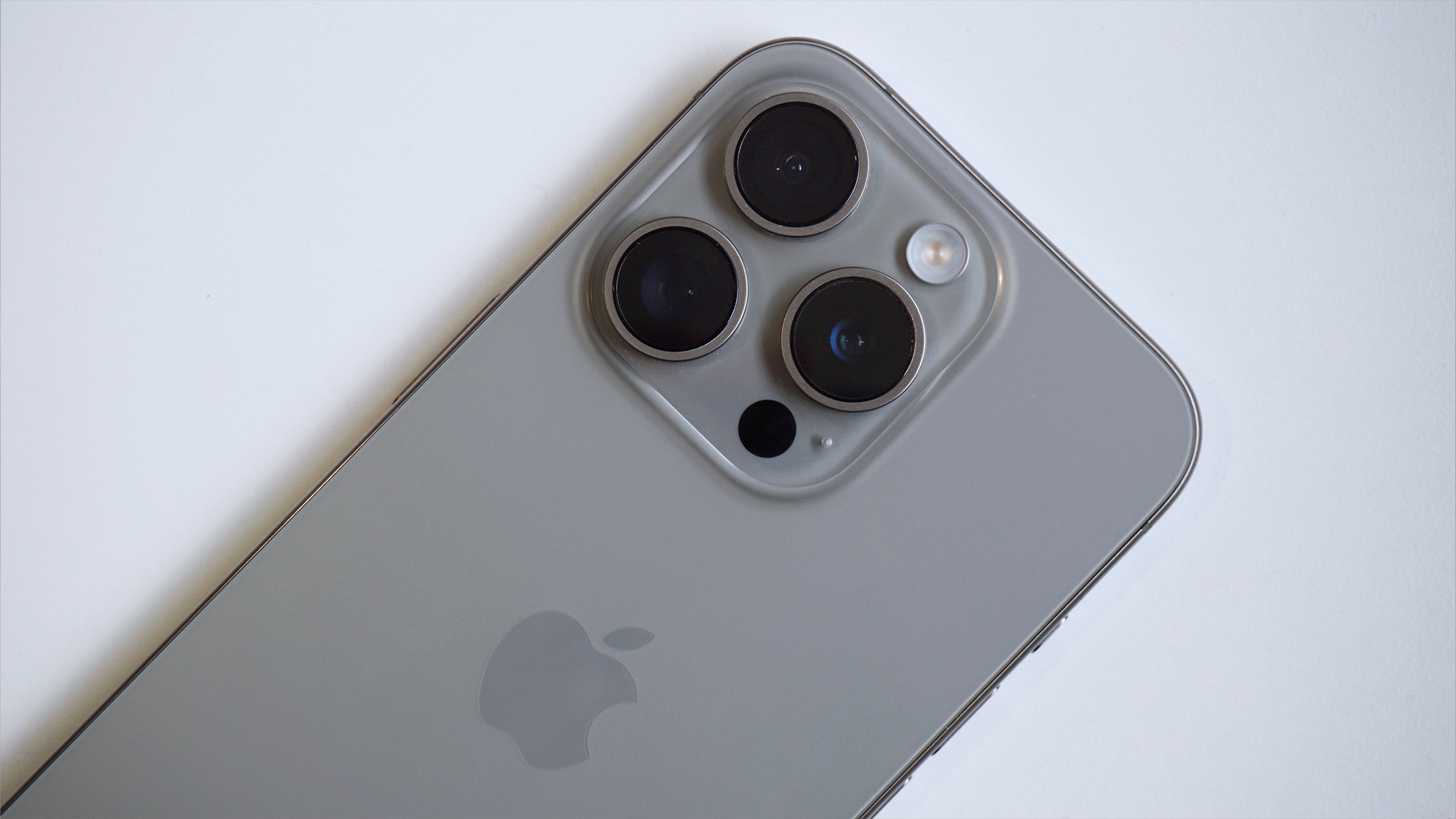
- 48MP main, 12MP ultra-wide, 12MP 3x telephoto
- Now supports ProRes at 4K/60fps w/ external storage
- Log video now supported
On the subject of cameras, the iPhone 15 Pro doesn’t stray too far from its predecessor’s (admittedly excellent) triple-sensor setup. On its back, the phone boasts a 48MP main, 12MP ultra-wide and a 12MP 3x telephoto sensor.
By reserving the 5x optical zoom telephoto camera for the iPhone 15 Pro Max, Apple has created a notable technological gap between its latest Pro and Pro Max iPhones this year, even more pronounced a disparity than the introduction of sensor-shift OIS (optical image stabilization) on the iPhone 12 Pro Max, which was absent on the standard 12 Pro. That doesn’t mean the iPhone 15 Pro isn’t one of the best camera phones around, however.
On the front, the iPhone 15 Pro sports the same 12MP TrueDepth camera as the iPhone 14 Pro, which is one of the better selfie snappers in the industry, with true-to-life colors, support for some of the iPhone's more advanced portrait still and video features, and boasting tight integration with social apps and filters found on the likes of Snapchat.
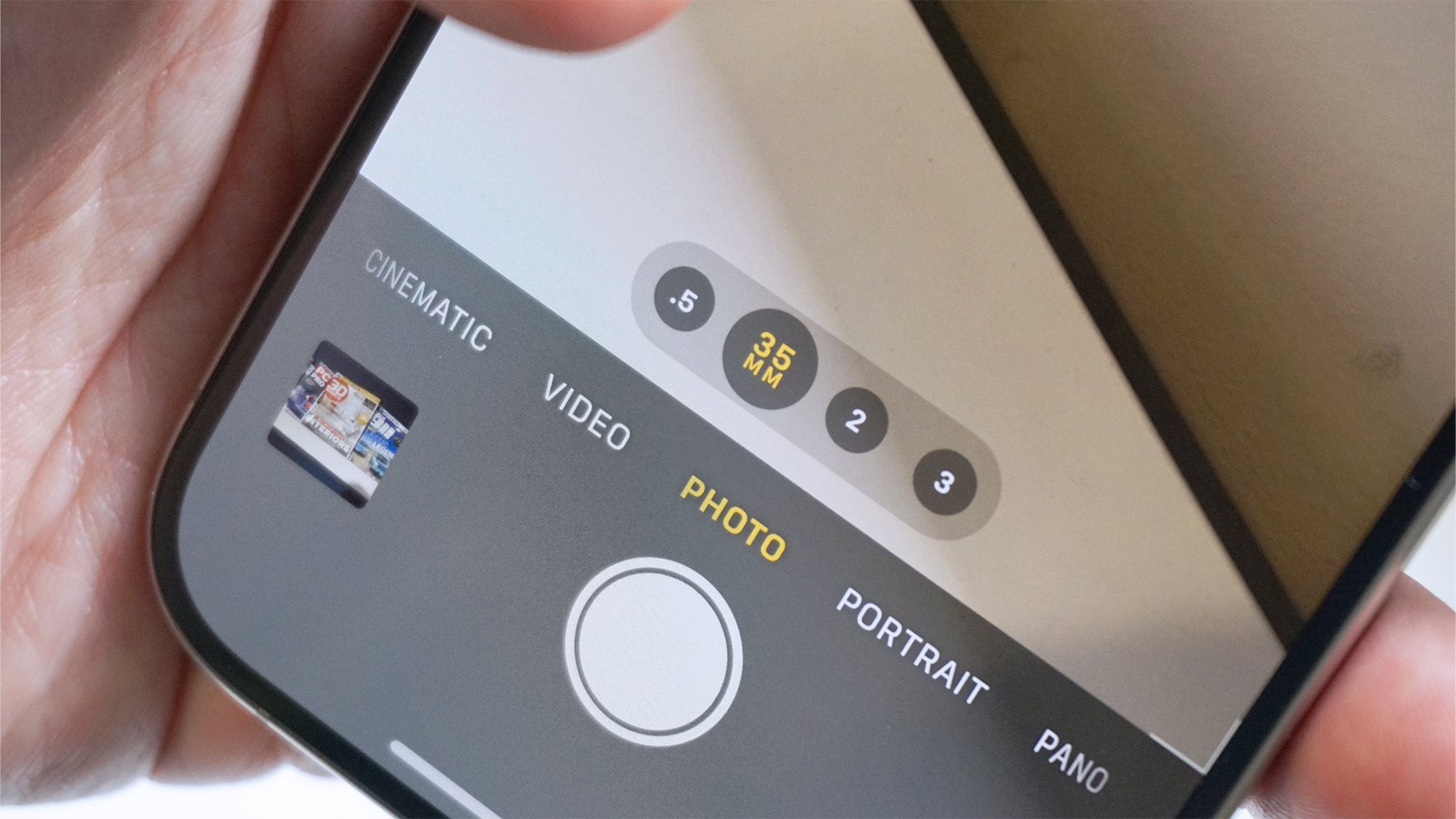
For all the similarities the camera setup has, compared its predecessor though, it does diverge in some meaningful ways, namely through the use of image processing tricks not present on previous entries in the series.
Facilitated by the 48MP resolution of the main sensor on all four iPhone 15 models (although the 15 and 15 Plus use a smaller, lesser sensor, compared to the Pros) – is the new default image capture resolution of 24MP (up from 12MP, which adds about a third to each image in terms of file size).
To reach that magic number, the 15 Pro fuses a 12MP image that's already run through the phone's imaging pipeline, with a 48MP full-resolution shot, to maximize detail, color depth, dynamic range and so on. Speaking of depth, you can now capture portrait shots after the fact, meaning you no longer have to switch to portrait mode to add more pronounced bokeh on stills, helping to bring your subject to the fore while blurring everything around them.
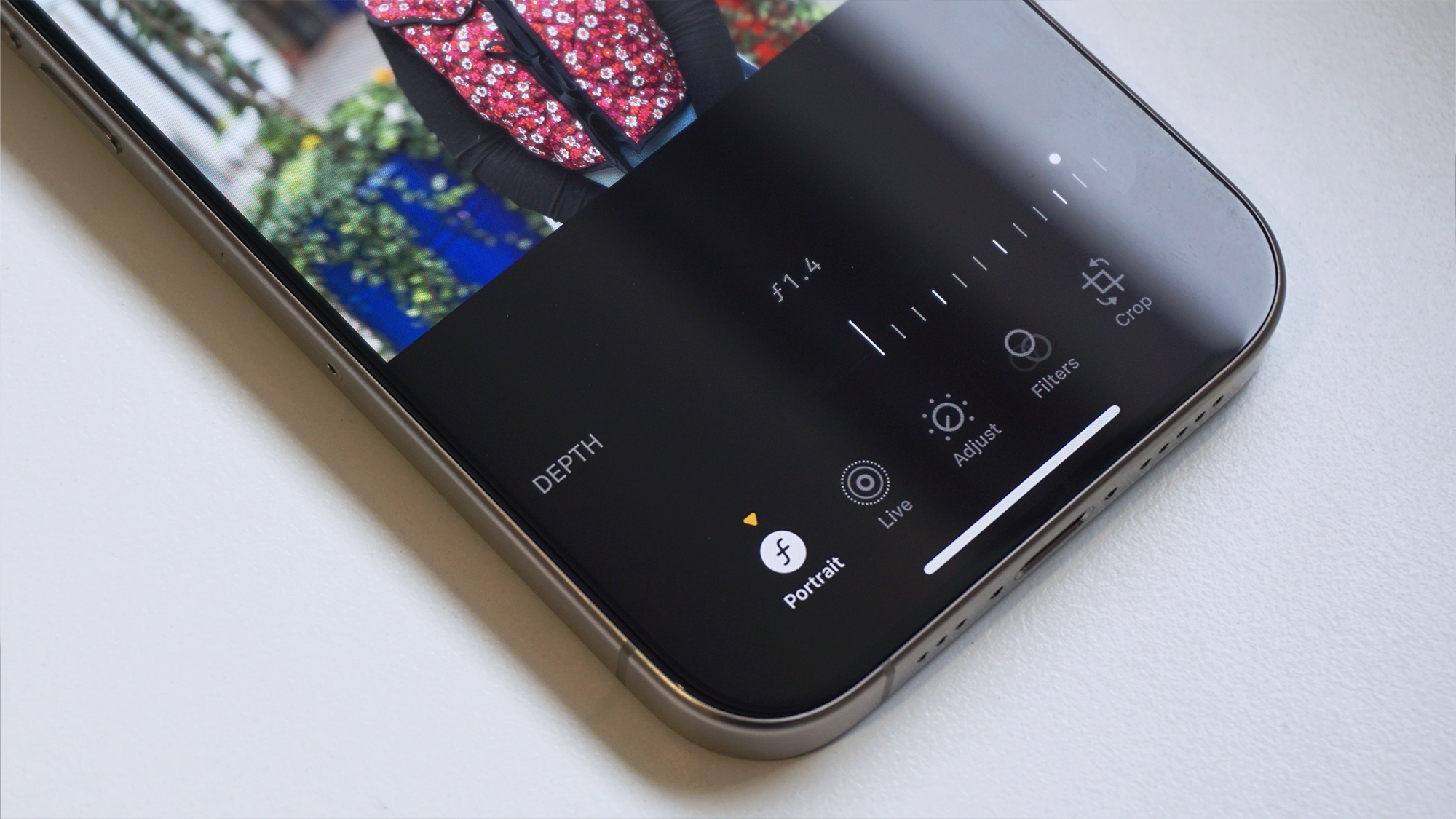
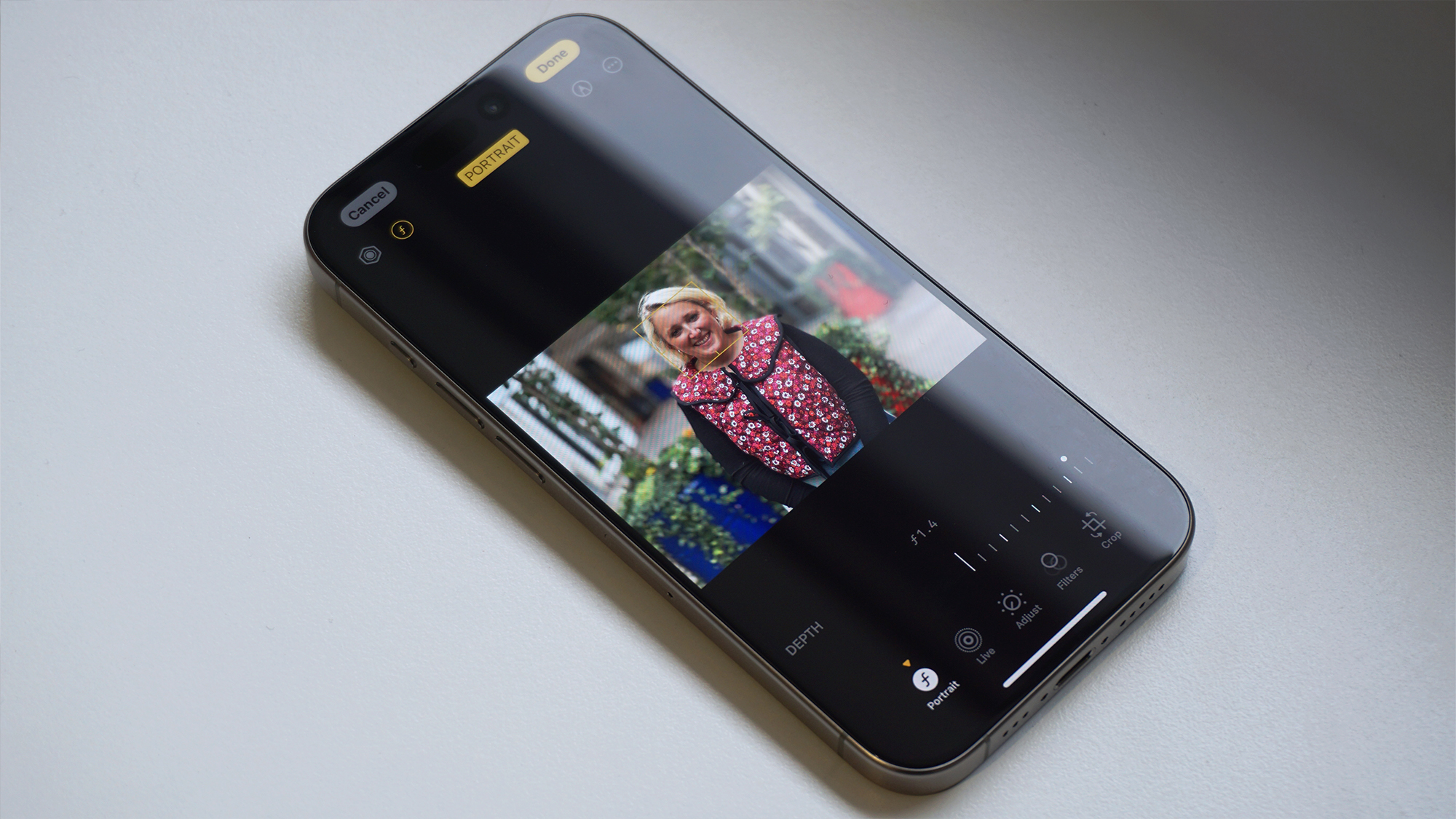
This feature isn't a binary either, with the ability to edit the amount of bokeh and even the option to tap to refocus between elements in the foreground and background after the fact, straight from the Photos app; provided the phone was able to detect a portrait-worthy subject to begin with.
Apple explained to me that, right now, the feature can detect people, dogs and cats; so expect to snap some upgraded imagery of your furry friends if you pick up a new iPhone anytime soon. And for those on the Android side of the fence, while phones like the Galaxy S23 can also pull off similar variable bokeh and refocusing tricks, attributes like edge detection aren't anywhere near as accurate and the images need to be captured in the dedicated portrait mode to begin with for the post-capture features to be accessible.
iPhone 15 Pro camera samples






Macro mode automatically engages when you're close enough to your subject, but you have the option to switch it off as desired.

Even if select rivals can capture more in even darker scenes, the results of the 15 Pro are some of the most pleasing to look at.

Color, contrast and detail aren't quite as full-proof as you'd hoped in artificial lighting, even if shots in such conditions remain pleasing to the eye, overall.


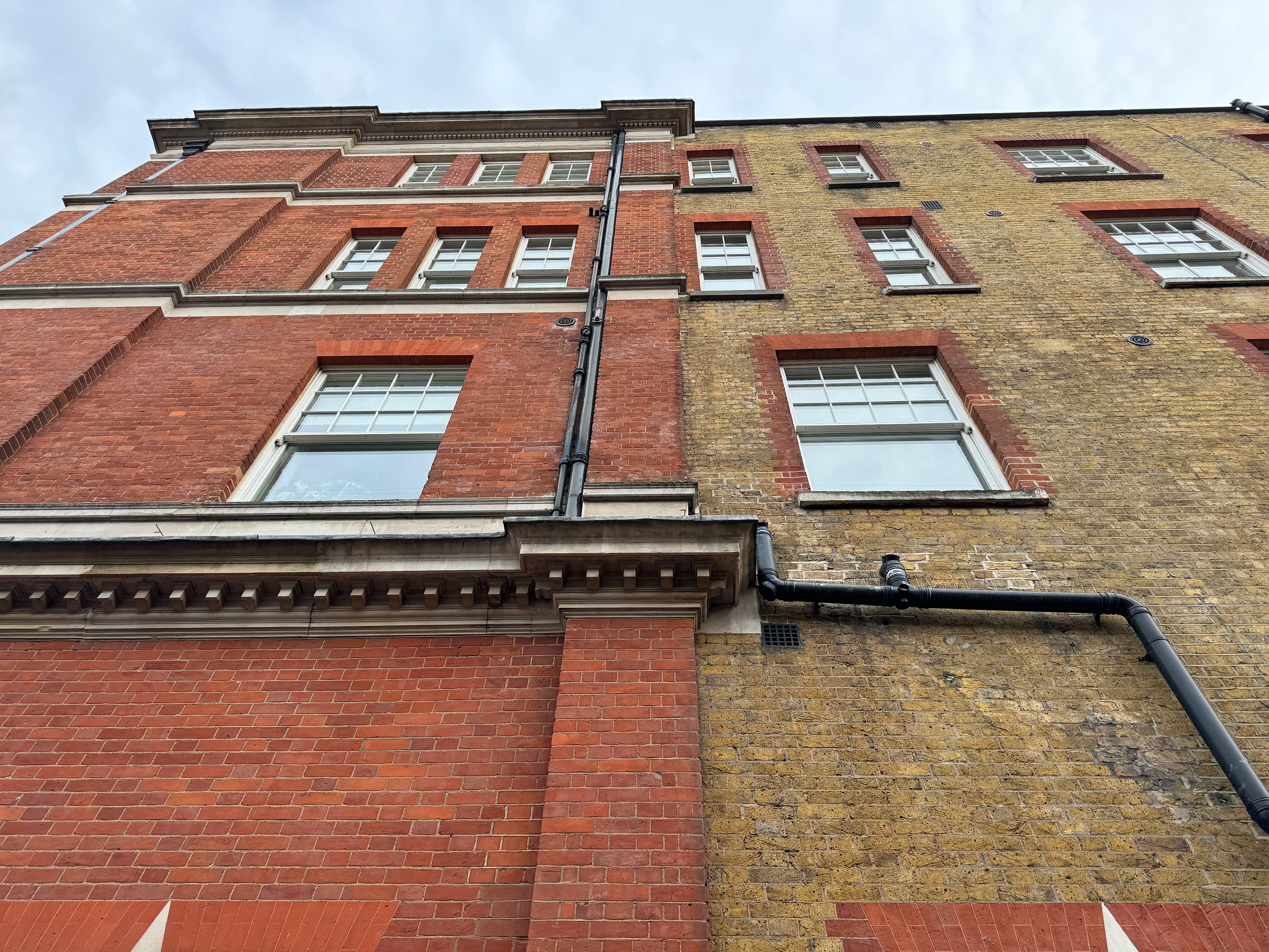
The iPhone 15 Pro has a great handle on dynamic range.



This shot didn't need the phone's new adjustable portrait mode functionality, as the lens's natural focal length came into play.

Portrait mode on the main 24mm lens.

Strong natural backlighting against dimmer, warmer artificial foreground lighting doesn't show the front-facing camera off in the best light.

Snapping a selfie in natural light without portrait mode engaged.

Snapping a selfie in natural light with portrait mode engaged.
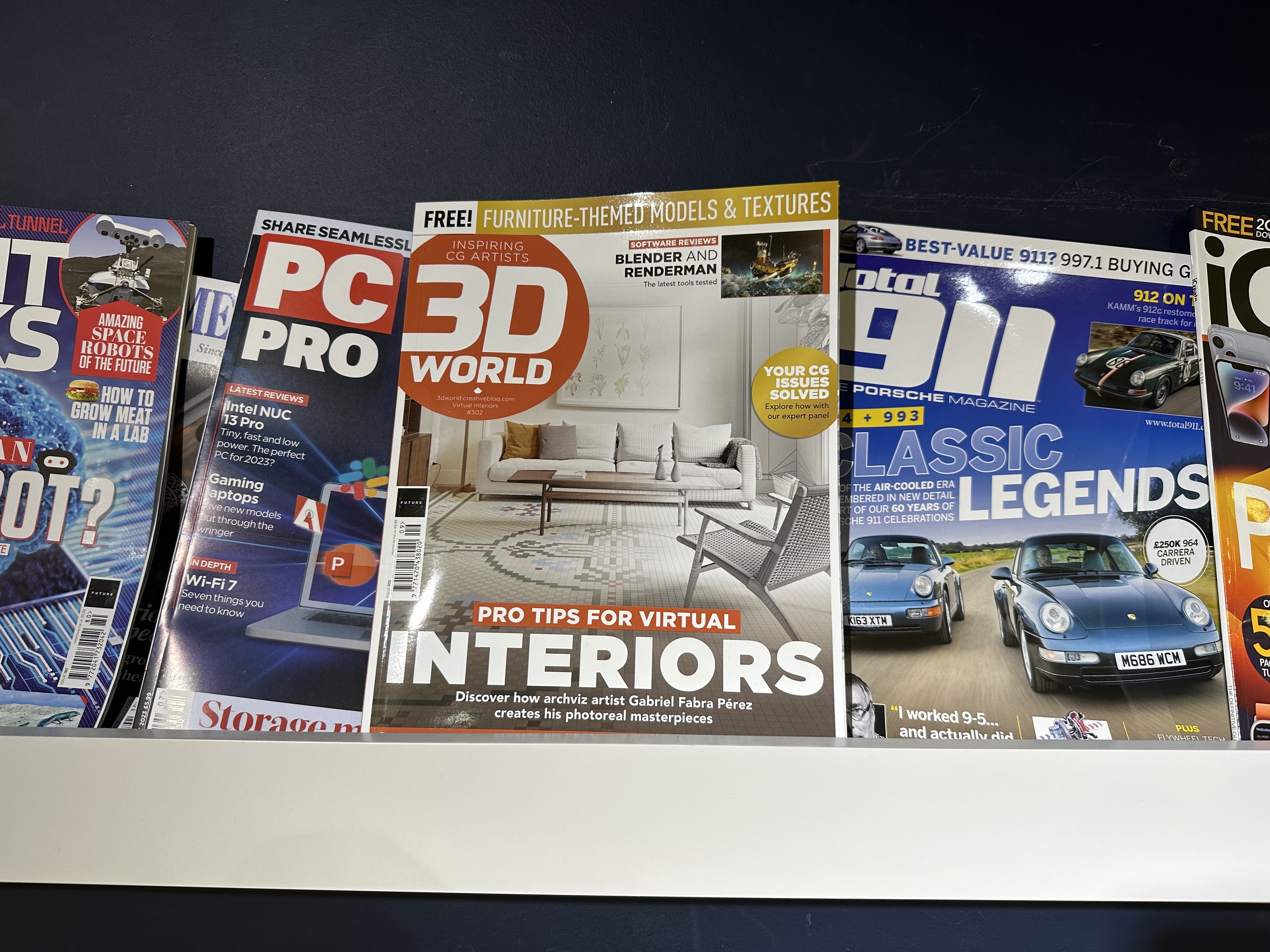
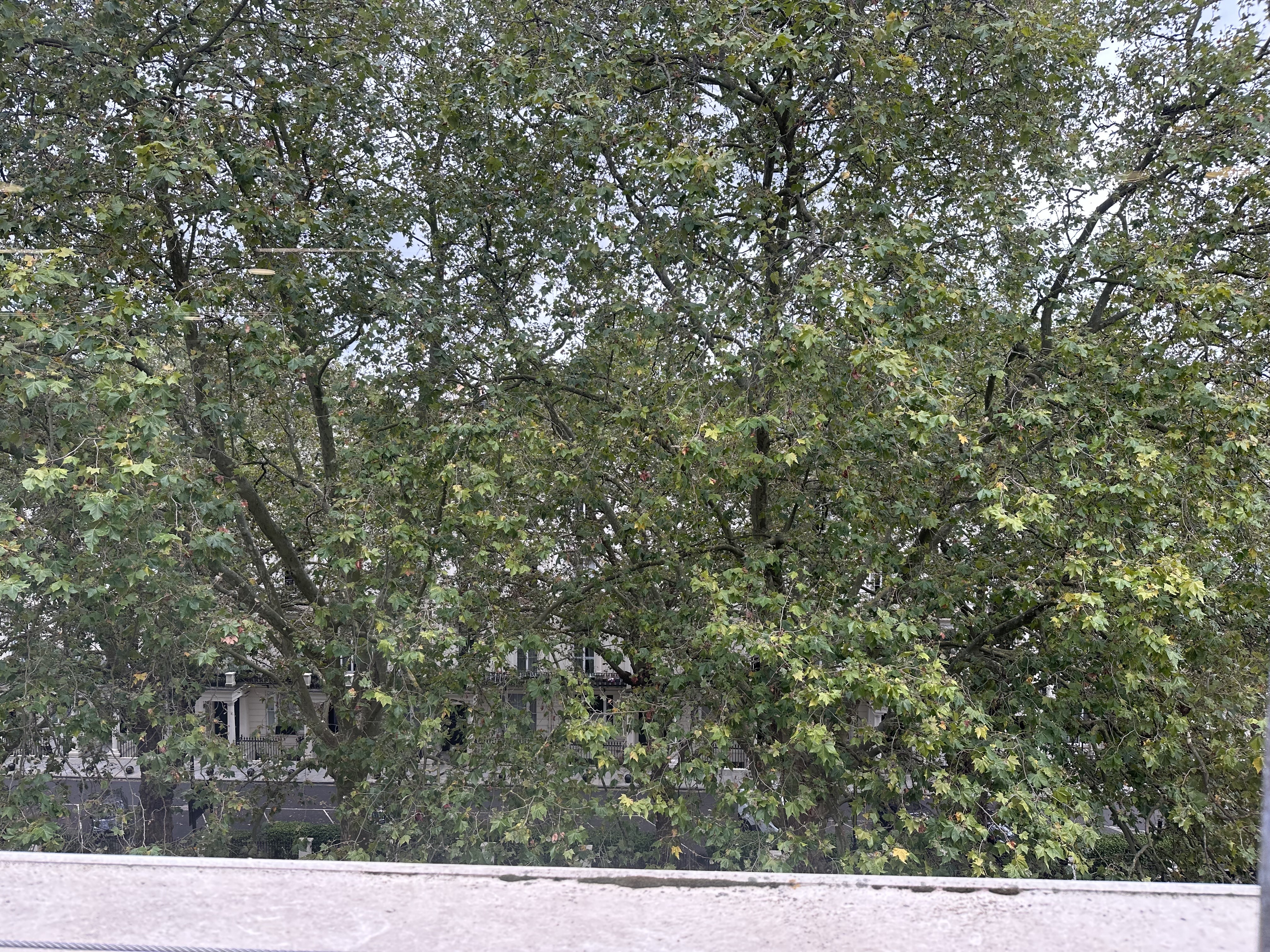
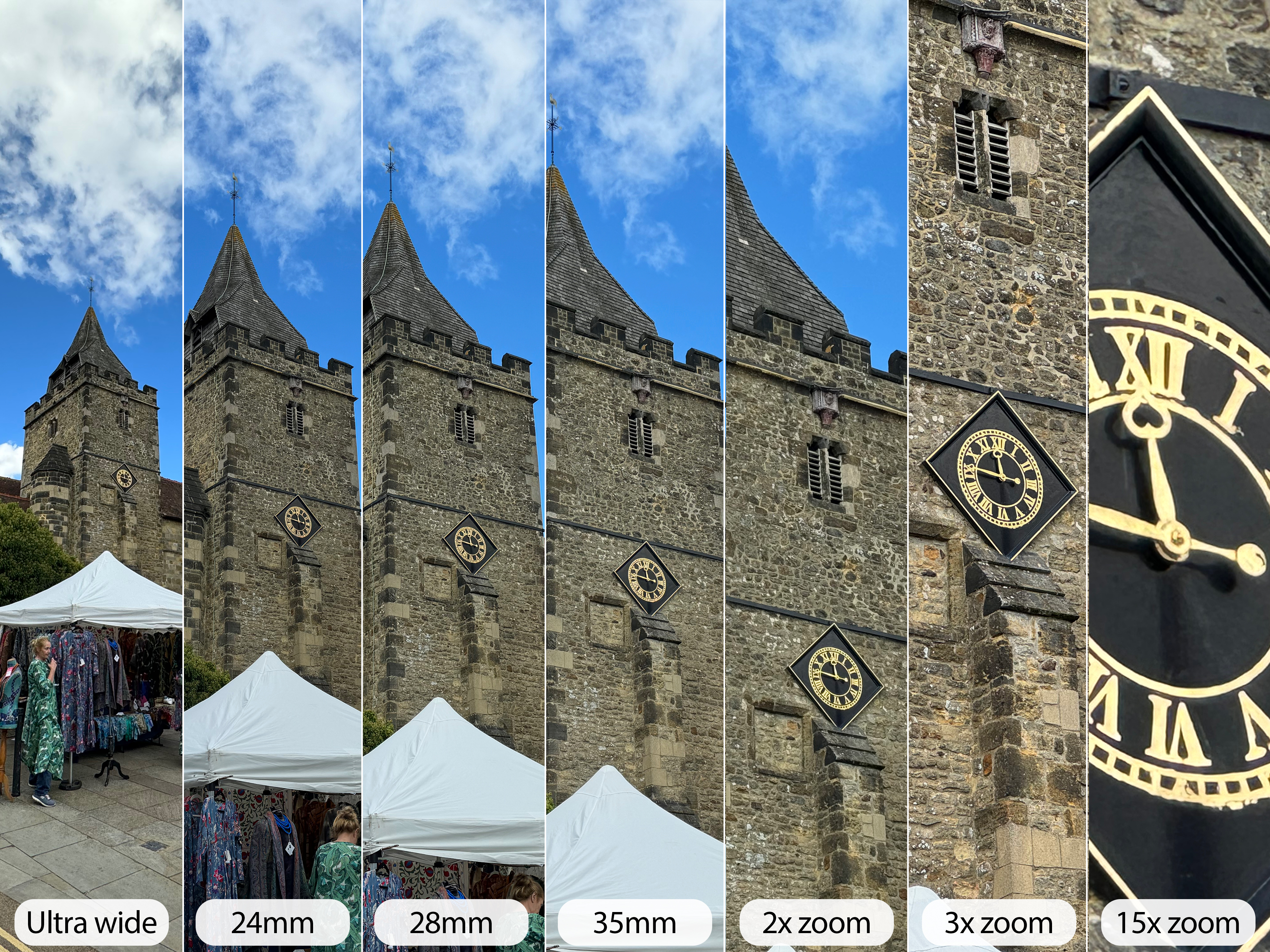
Examples of the iPhone 15 Pro's zoom range, through to its 15x digital maximum, in natural light.
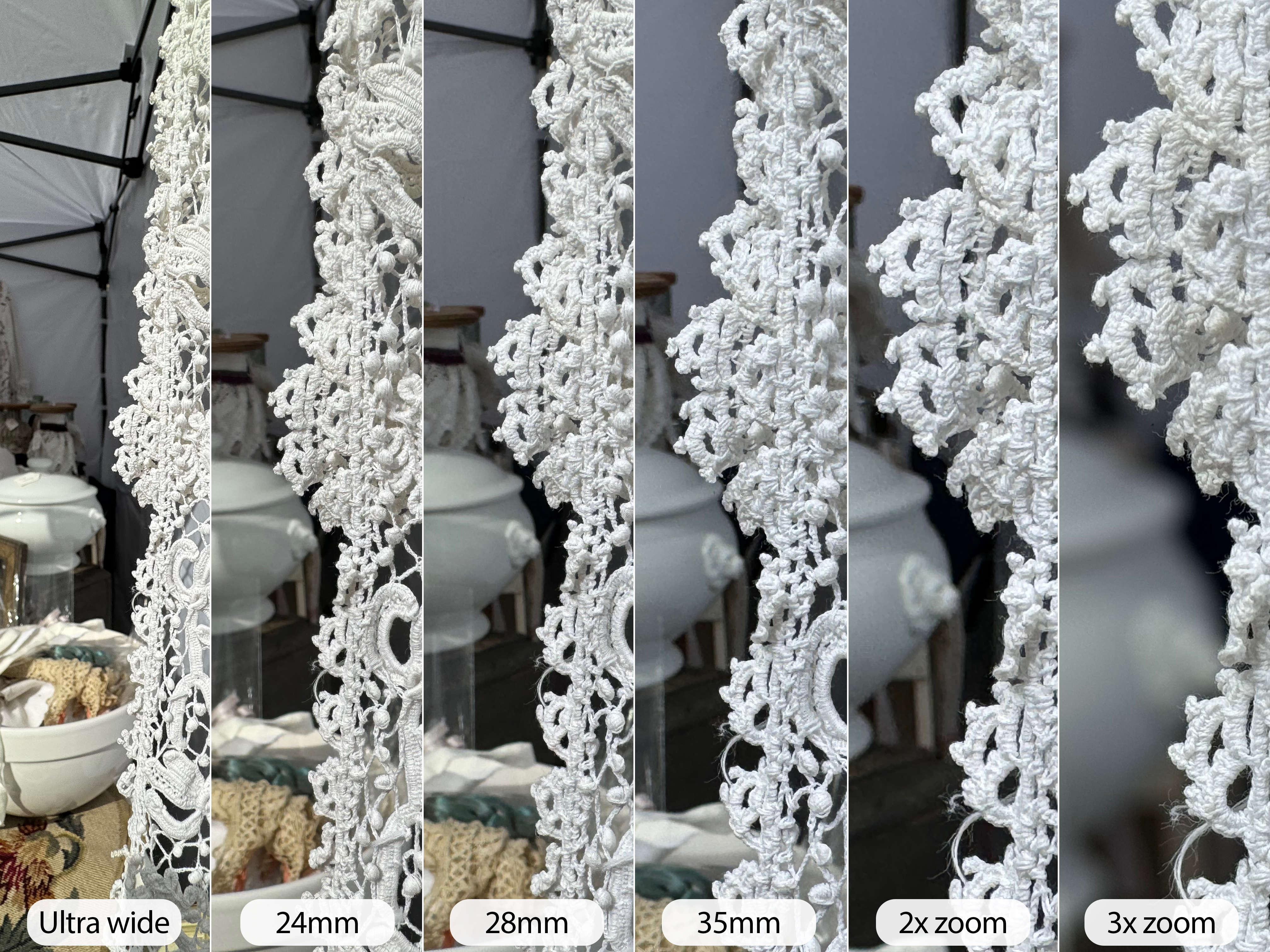
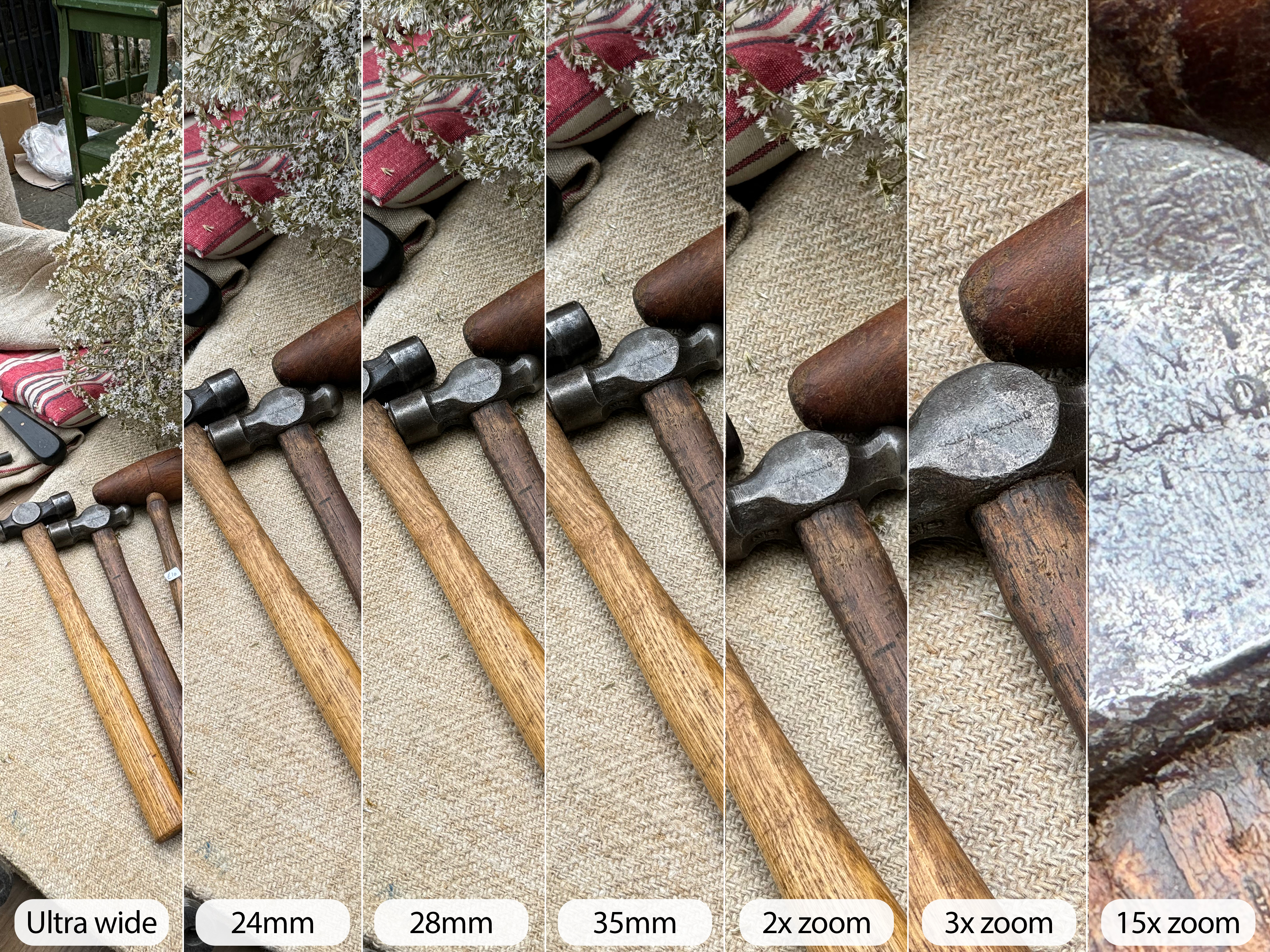
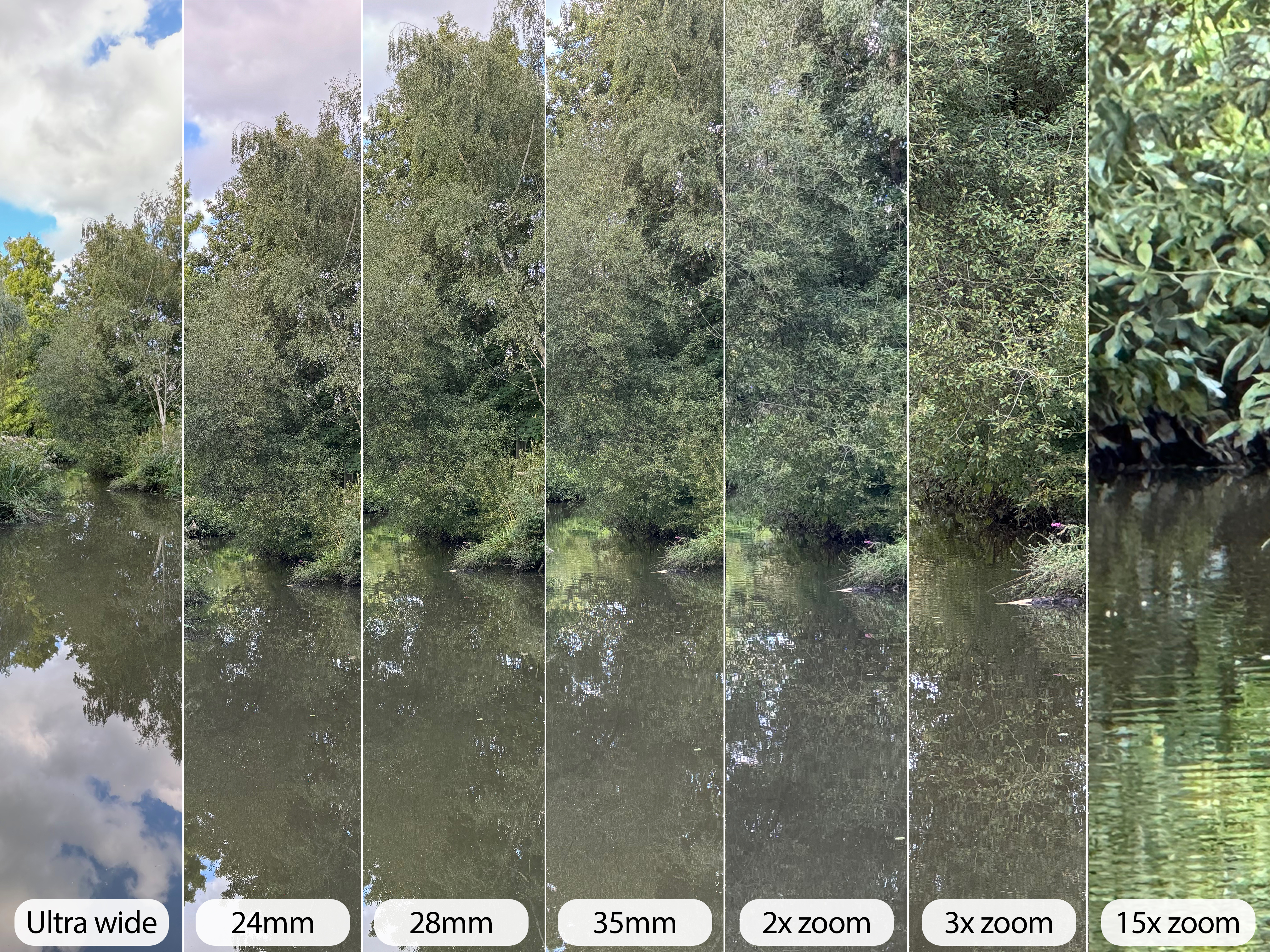
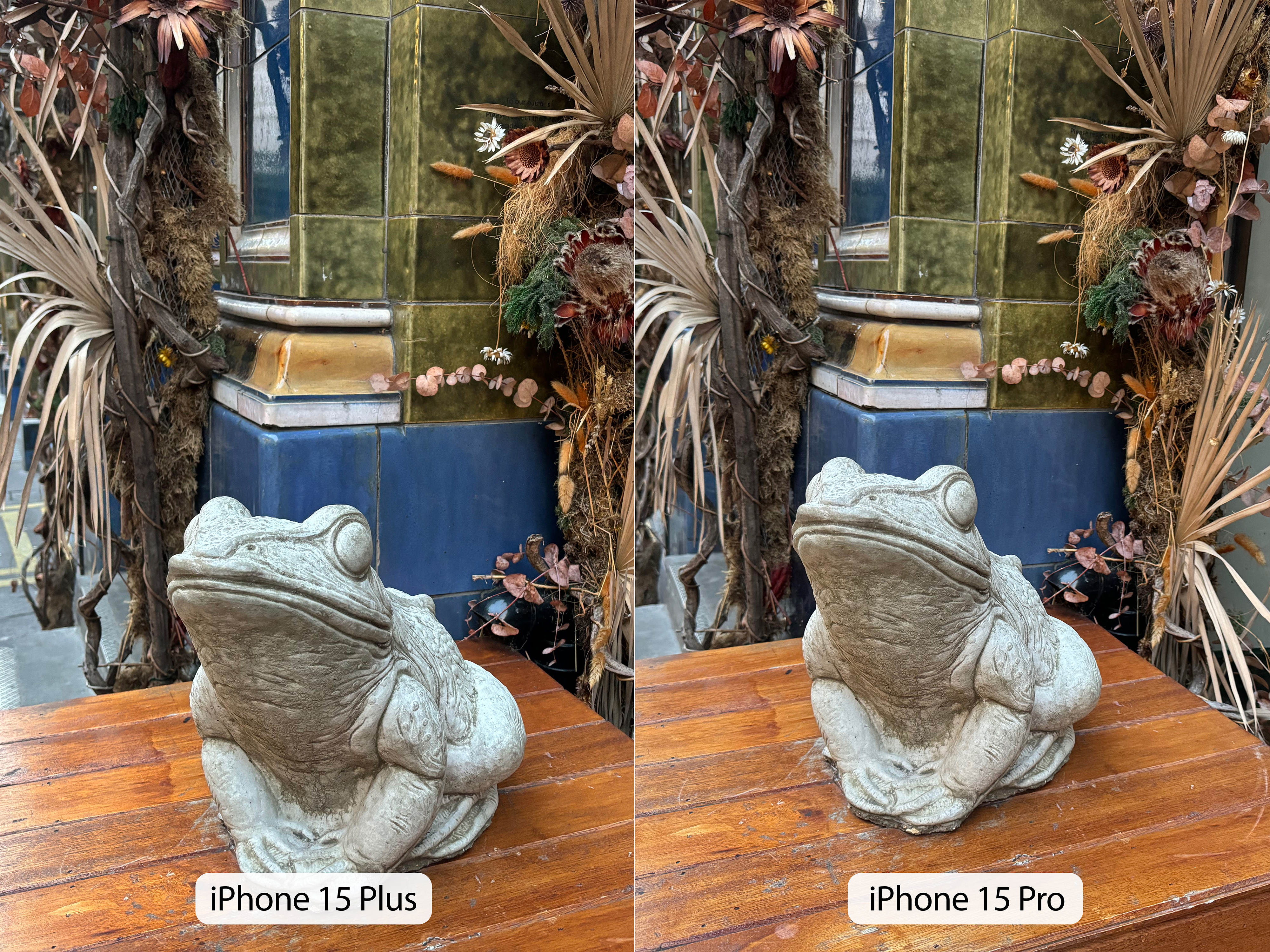
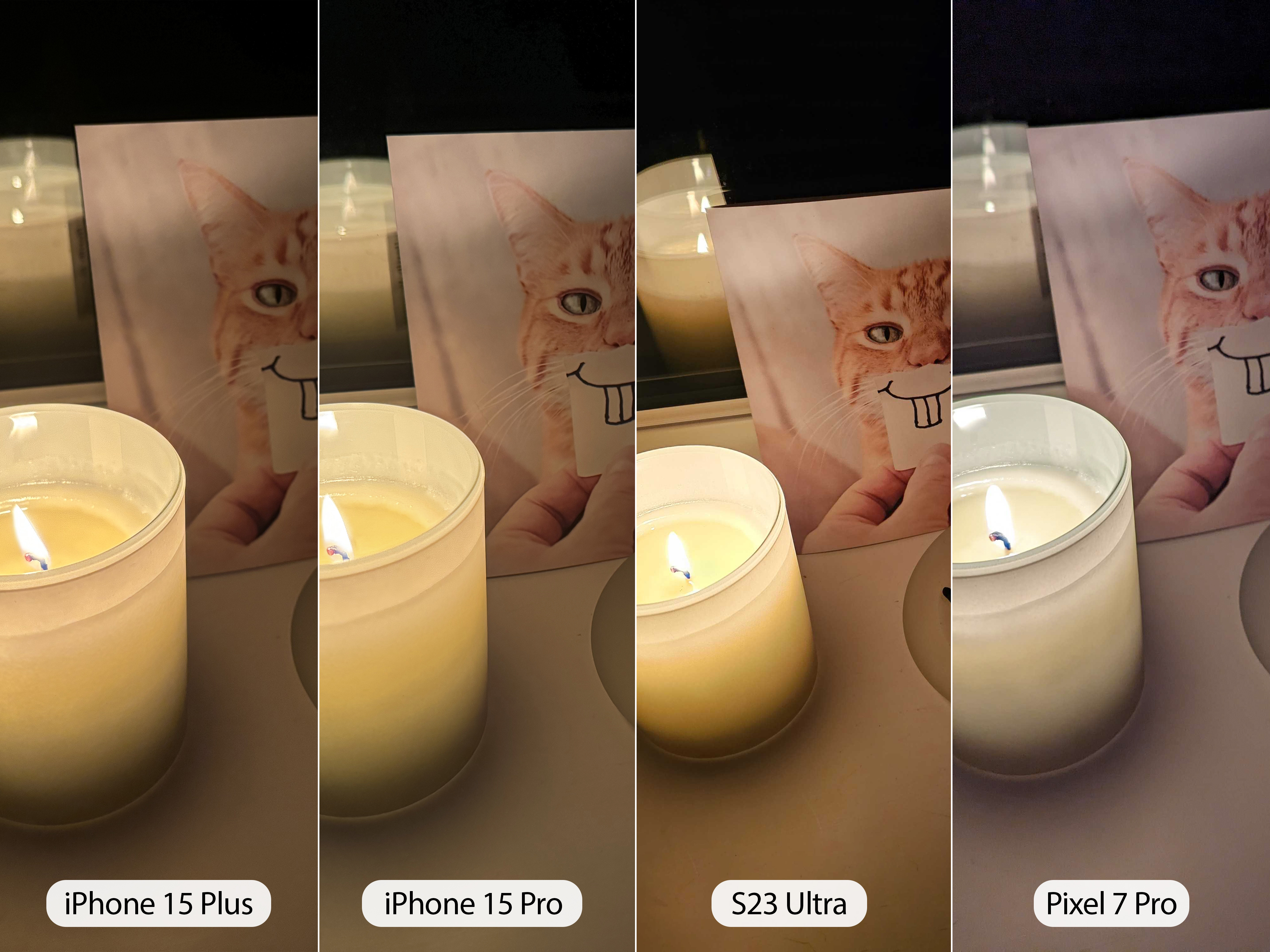
Reiterating my point from earlier, the iPhone 15 Plus and Pro used in this comparison offer the best exposure and detail on the candle, whereas the S23 Ultra boasts greater contrast at the expense of dynamic range, while the Pixel 7 Pro completely misjudges the color in the scene.
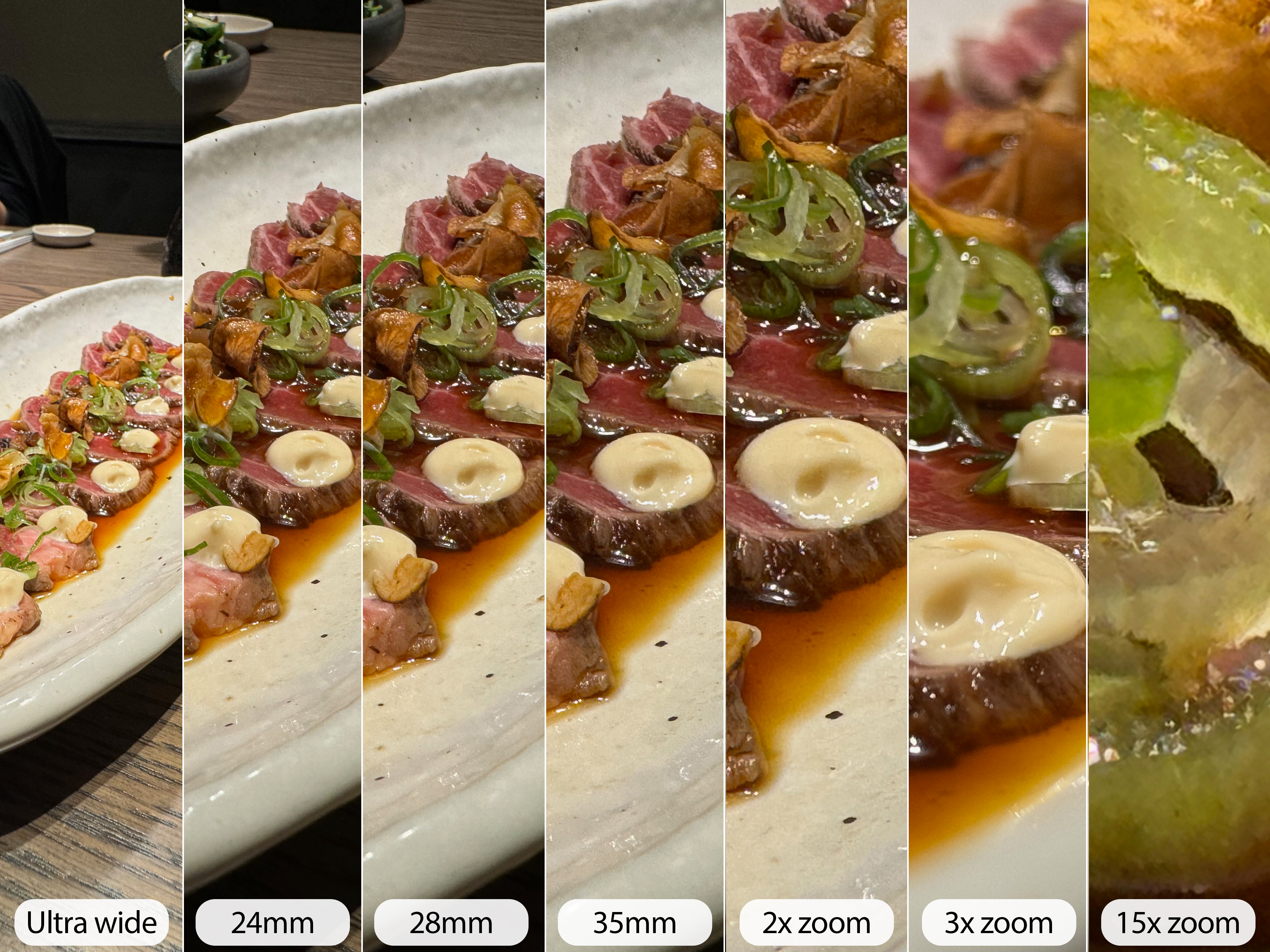
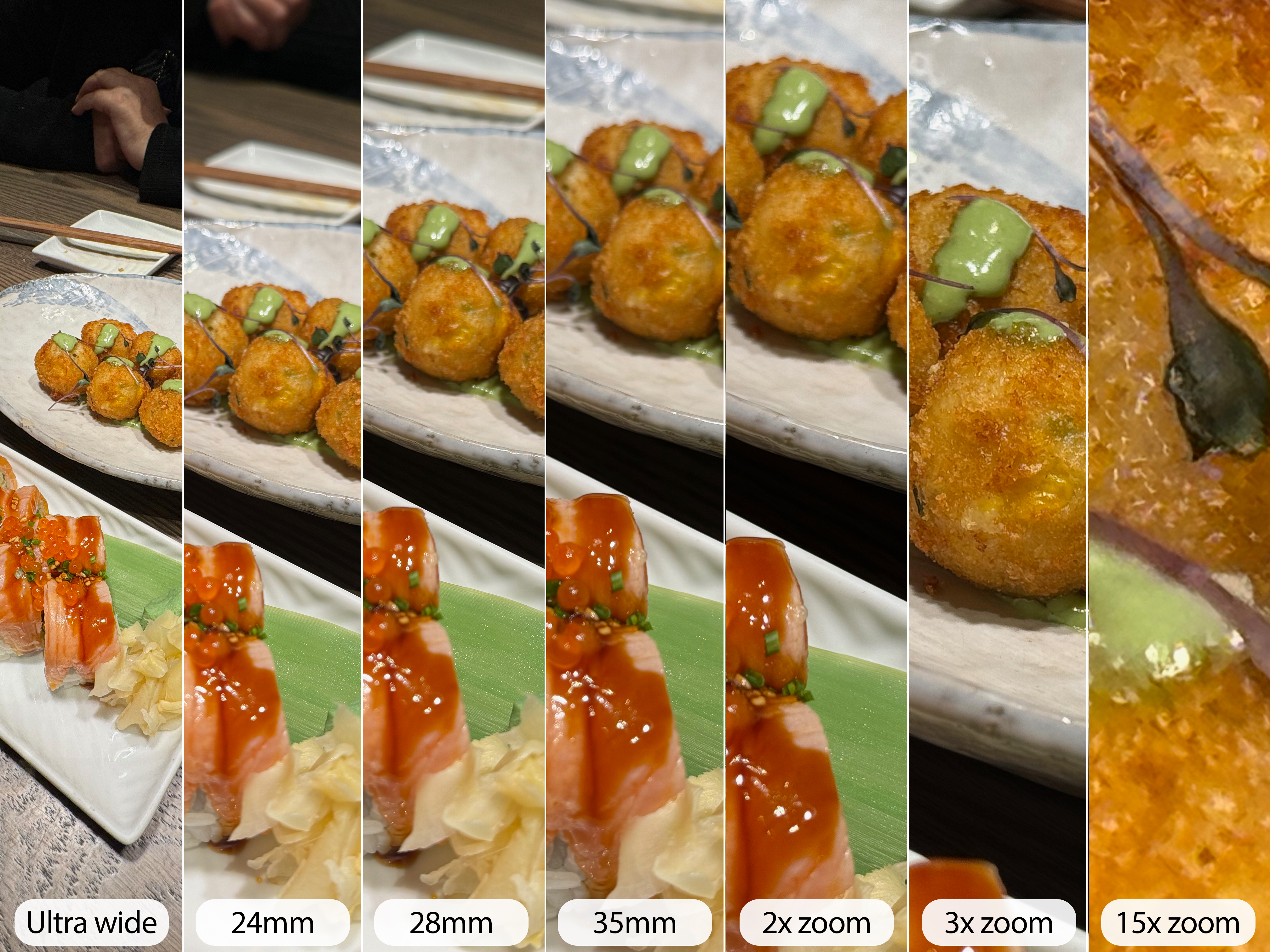
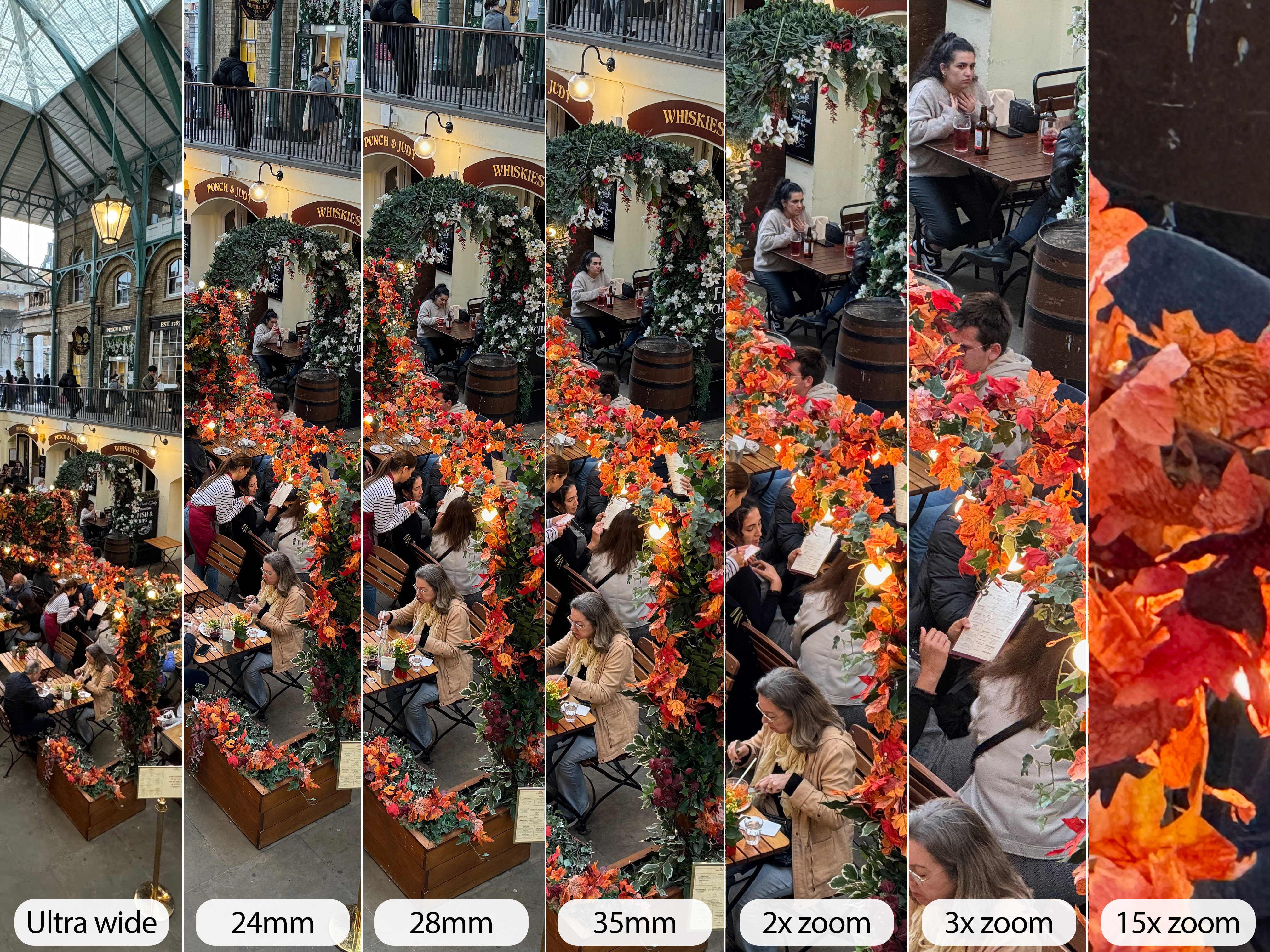
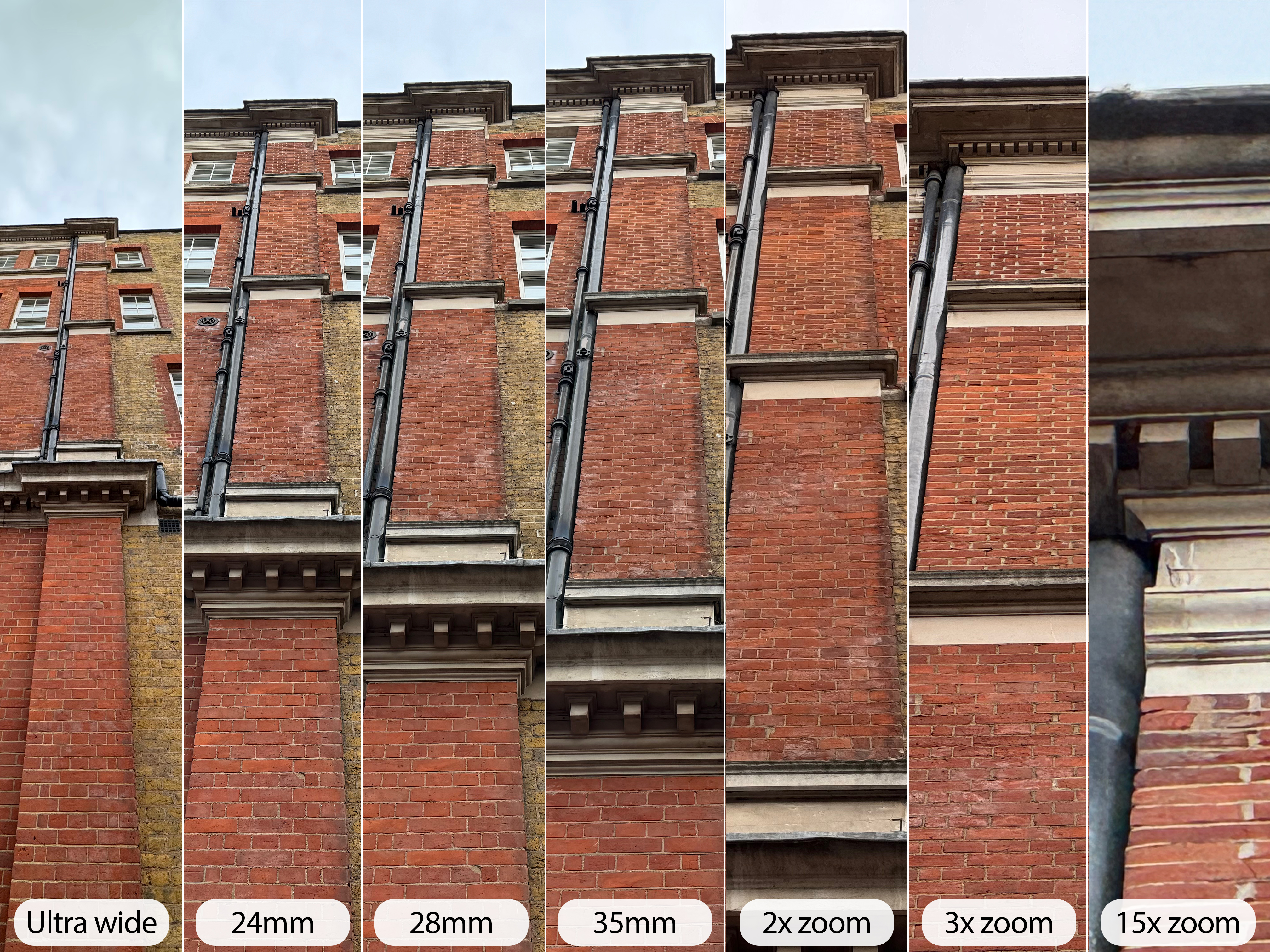
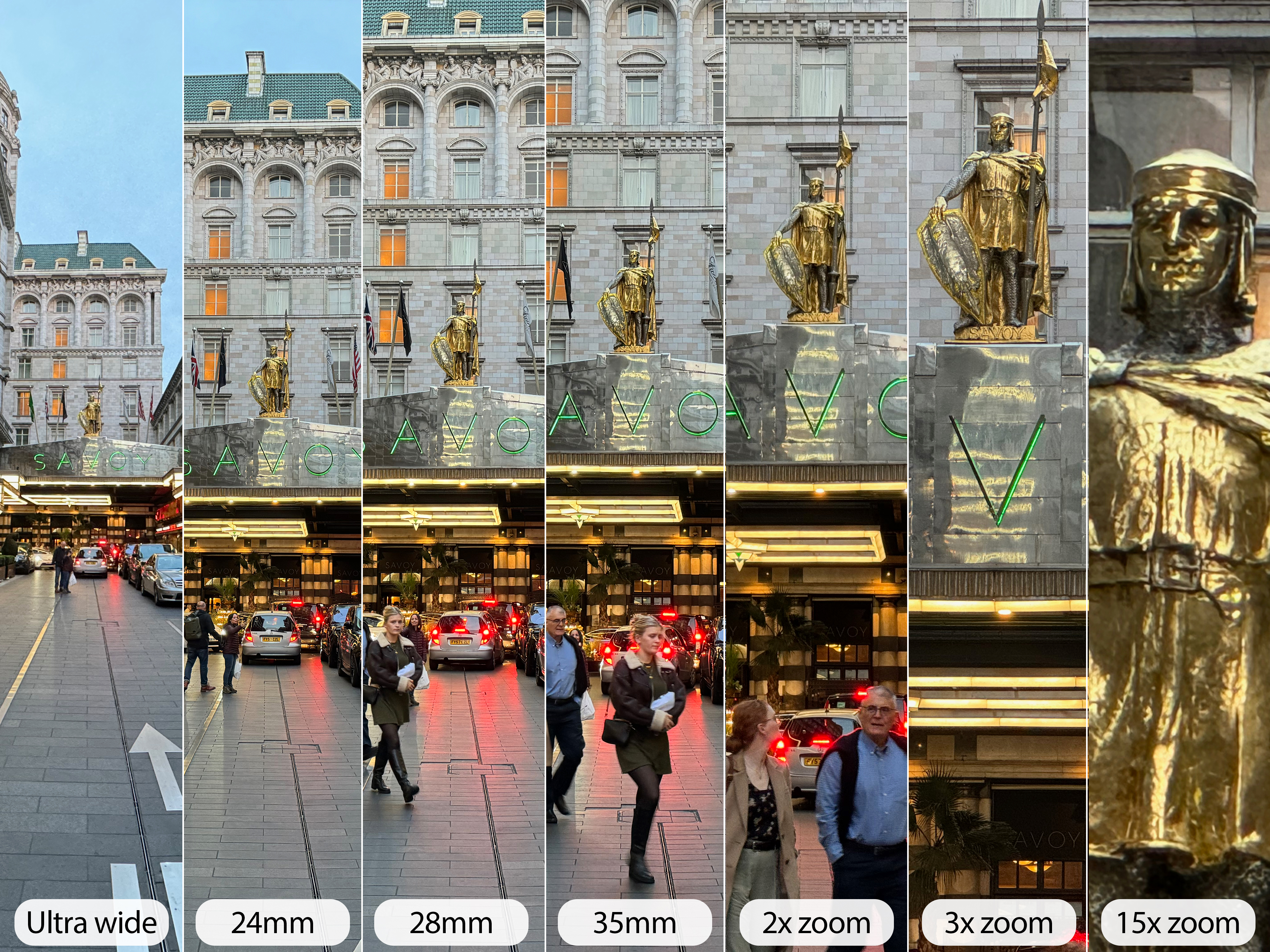
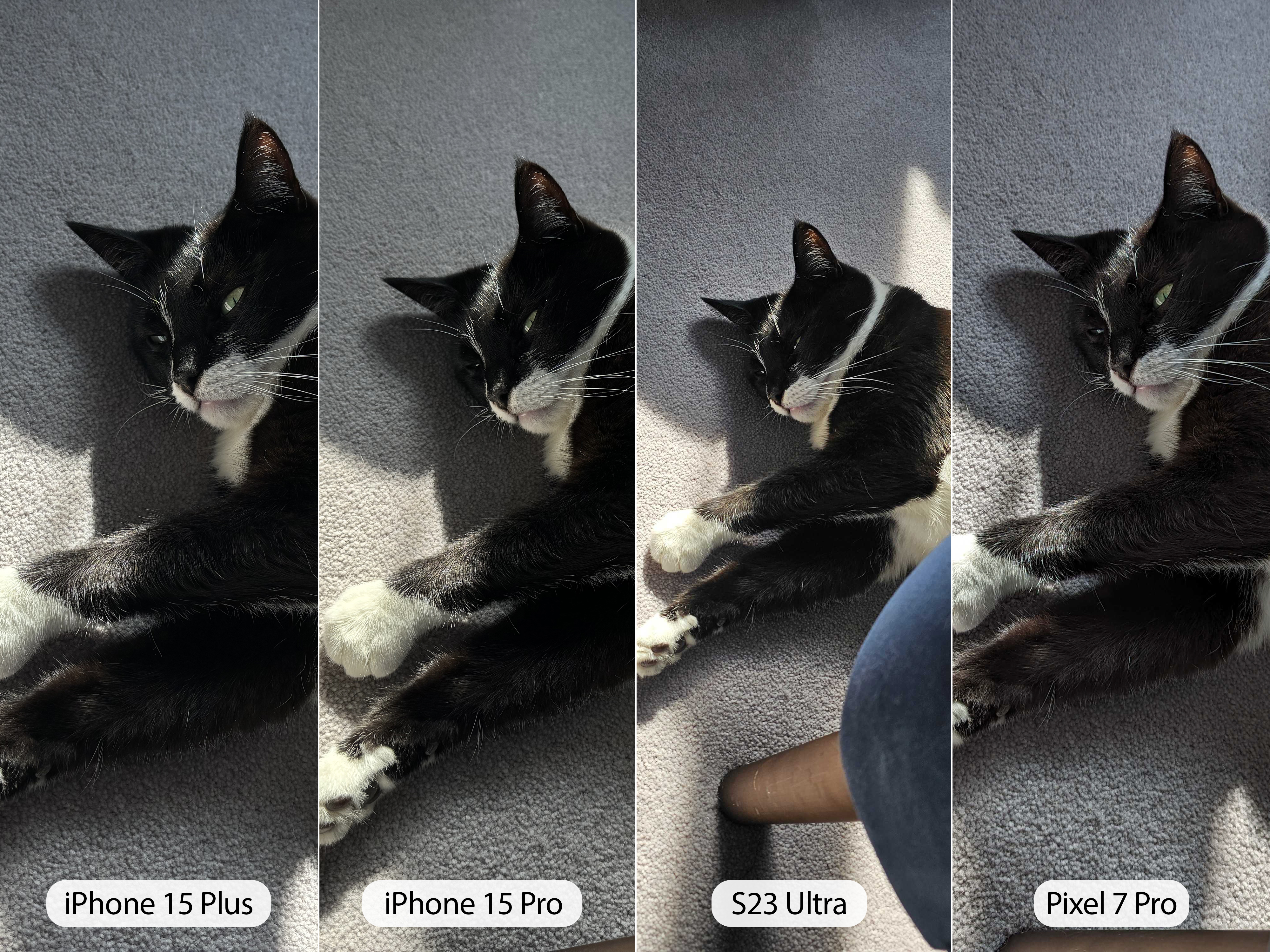
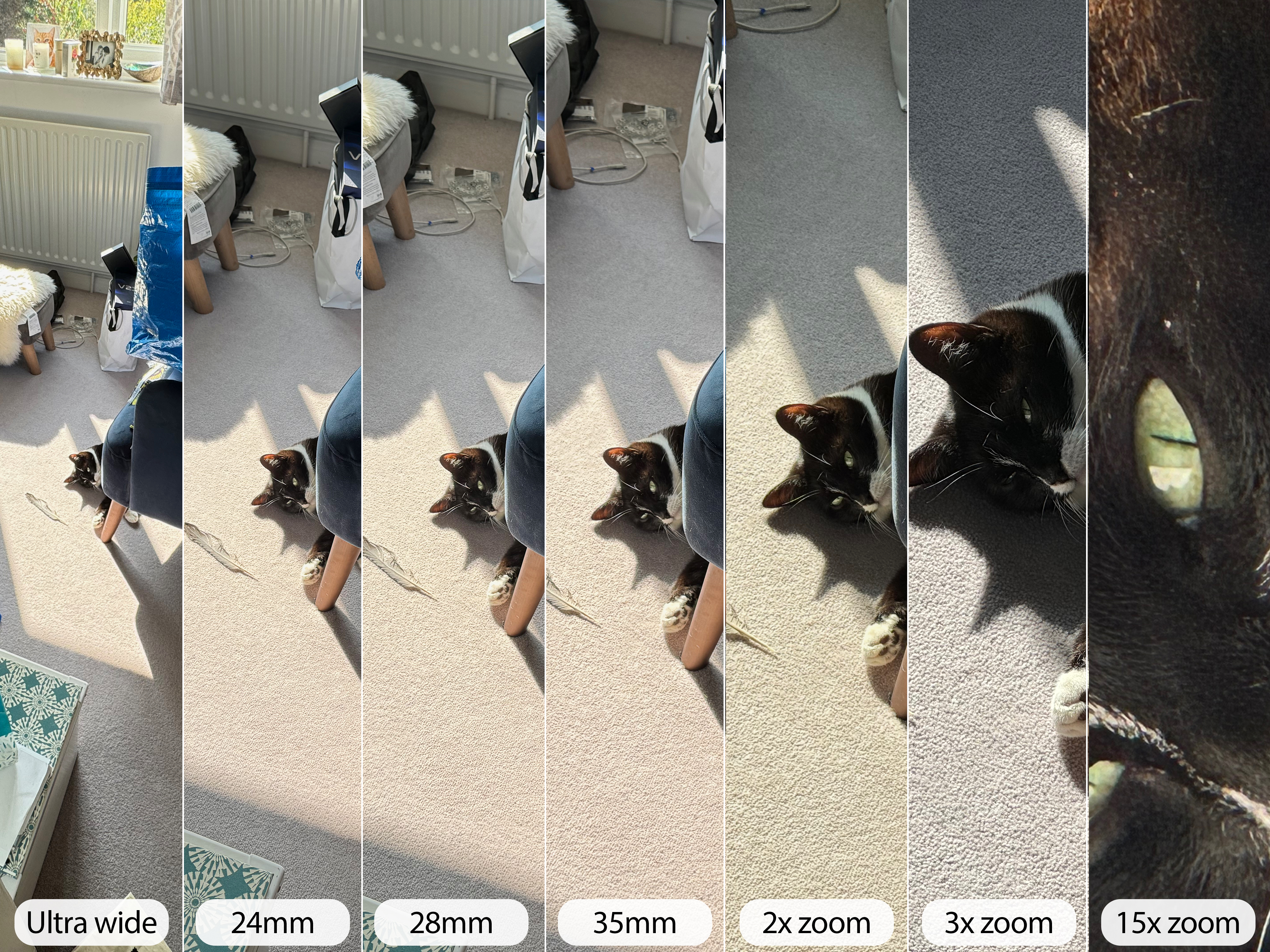
It looks as though the 15 Pro assesses color and light based on the whole frame, which can vary as you zoom in on a subject, resulting in the uncharacteristic color temperature change present at 2x and 3x zoom ranges.
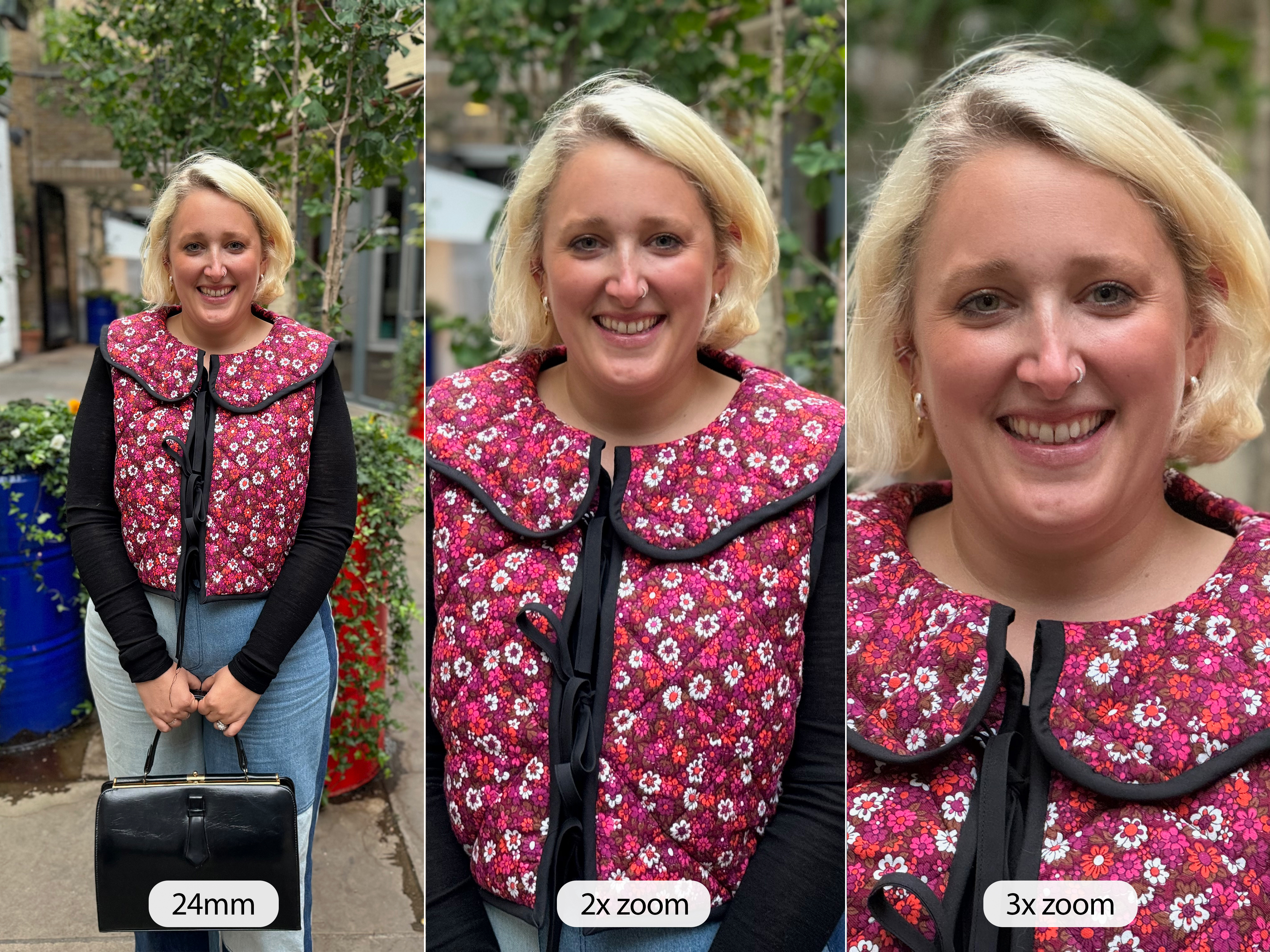
The degree of bokeh behind a subject when shooting in portrait can vary pretty significantly as you move through the phone's dedicated zoom telephoto distances.
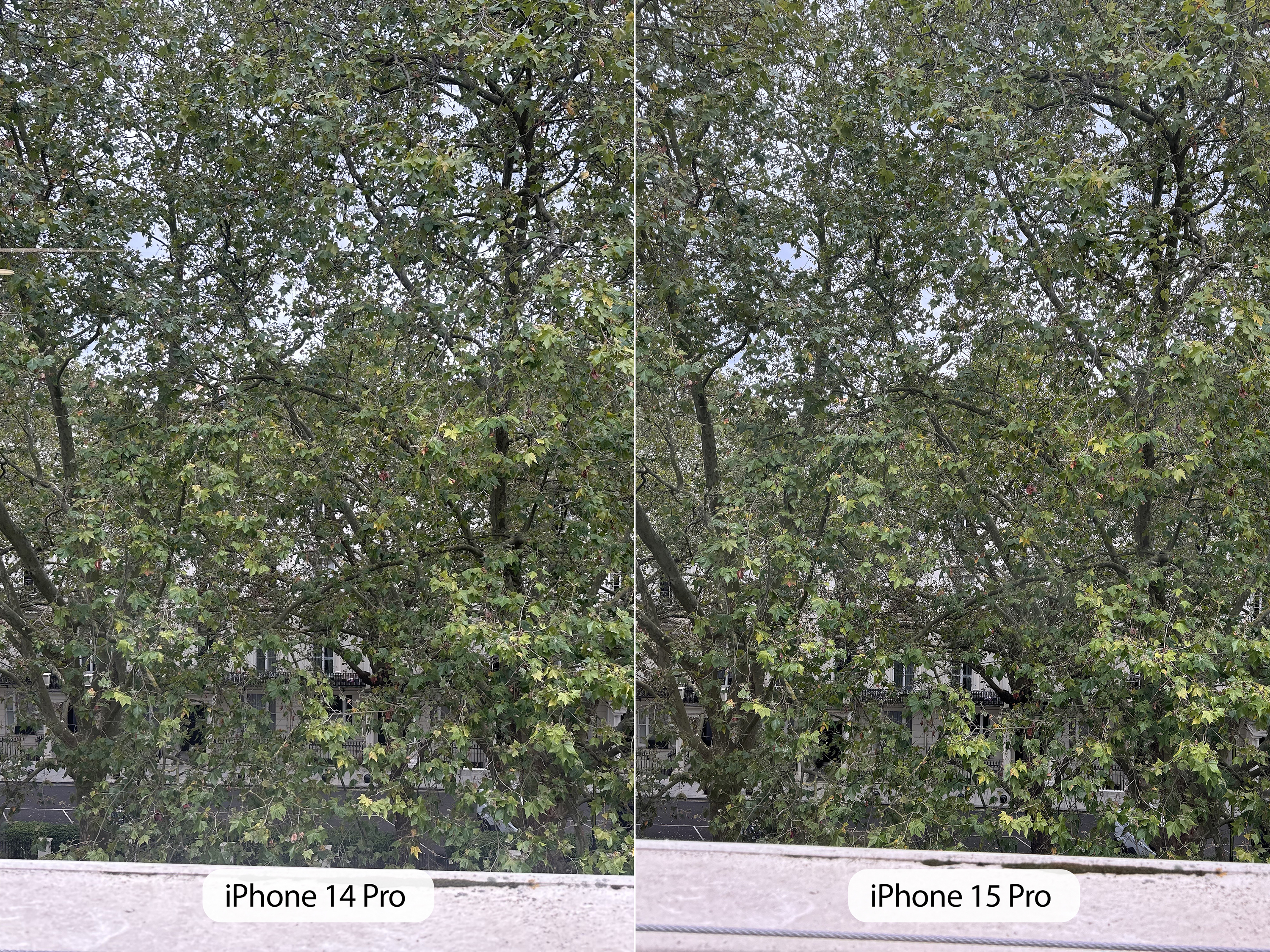
The 15 Pro's main camera unquestionably serves up more vibrant and contrasted images than its predecessor's.
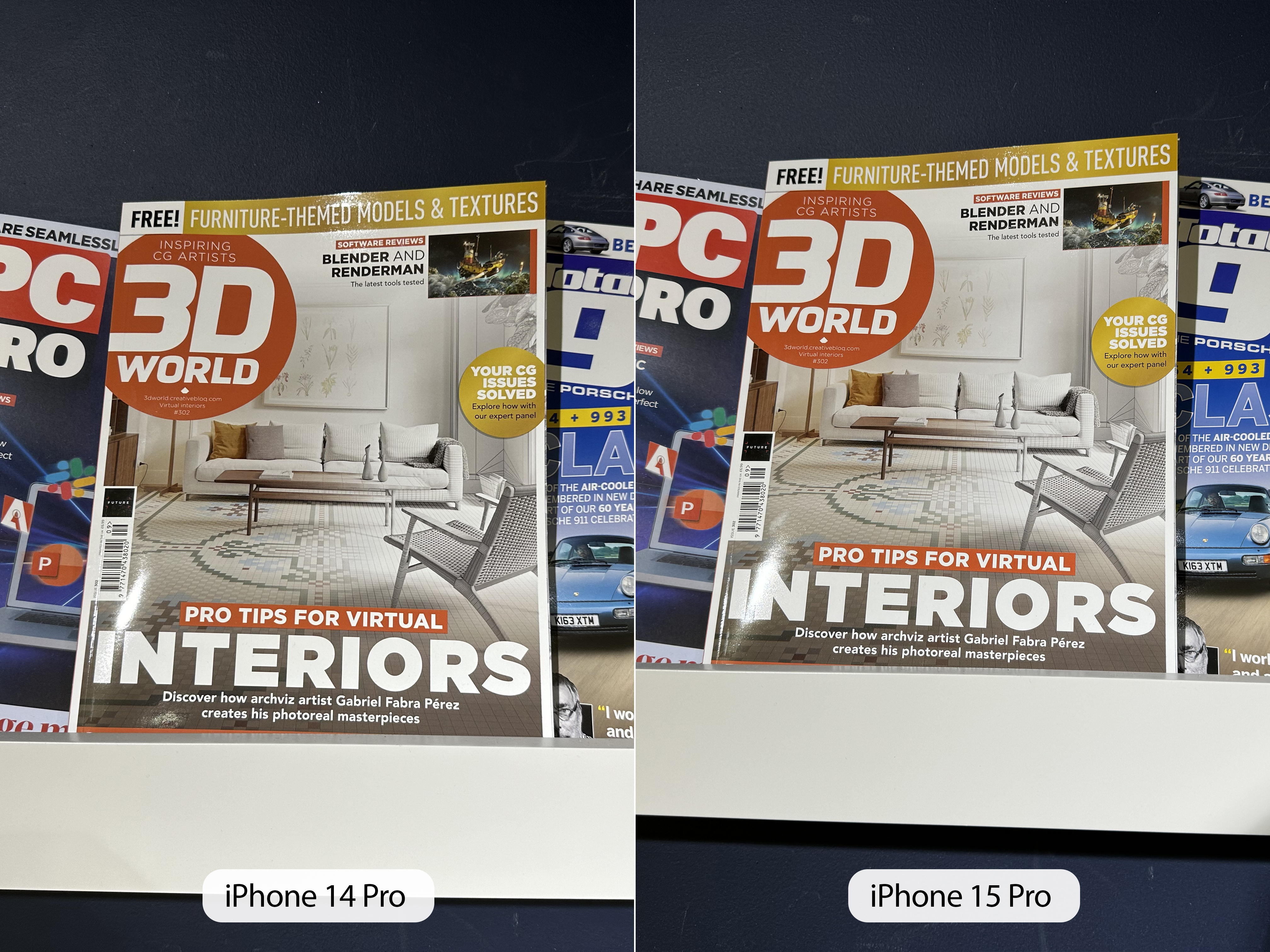
Despite three lenses and seemingly no new 5x optical zoom – as on the 15 Pro Max – Apple still highlights the iPhone 15 Pro's apparent seven total focal lengths (excluding the front camera): the 13mm ultra wide – which also includes a dedicated macro mode, with a minimum 2cm shooting distance, the 24mm main – along with a 28mm and a 35mm mode – all three of which can capture at 24MP, the 2x lossless sensor crop on the main camera and finally, the 77mm 3x telephoto (those last two of which capture at 12MP).
While the experience of shooting still on the 15 Pro will feel immediately familiar to long-time Pro users, in side-by-tests with its predecessor (see one highlighted example below), it's clear that Apple has opted for a more pronounced default for the color science at play; resulting in more vibrant colors and harsher contrast that offers a little more 'pop', towards the direction of Samsung's phones and away from the accuracy of Google's Pixels.
When the lights drop down, the 15 Pro also handles itself better than any of its most prominent rivals, with regards to showcasing dynamic range and preserving details, color and depth. Shots taken in extreme darkness and astrophotography are party pieces better left to the likes of the Pixel 7 Pro, though.
There's also video the speak about, which is where the Pro really earns its name. It's interesting that Apple continues to push its most powerful iPhone camera features towards industry rather than consumer. But thanks to the power of the new A17 Pro – alongside the adoption of USB-C (with those faster data speeds) – the 15 Pro (and Pro Max) now support Apple ProRes video recording at up to 4K/60fps, when connected to an external storage device (still 4K/30 for on-device recording). There's also the addition of Log capture too, which, like RAW capture for stills, gives footage a flat color profile with straight-from-the-sensor output (meaning larger files than standard video and thus the need for external storage support) ripe for editing and color-grading within a professional workflow.
For everyone else, just know that, even if the color science packs a little more 'pop' as standard (in the direction of Samsung's phones), like its predecessors the iPhone 15 Pro offers one of the the most consistent and reliable camera experiences across both stills and video.
Do I wish the 15 Pro had the Pro Max's 5x optical telephoto? Of course, but I assume Apple's figuring out how to squeeze that periscopic tetraprism design into a 6.1-inch body, in time for the launch of the iPhone 16 series, next year.
While it's not something I'm able to test at this stage, it's also worth noting that both new 15 Pro models will also be capable of capturing Apple's Spatial Video format (3D videos) meant to be viewed on its upcoming Apple Vision Pro headset.
- Camera score: 4.5 / 5
iPhone 15 Pro review: Performance
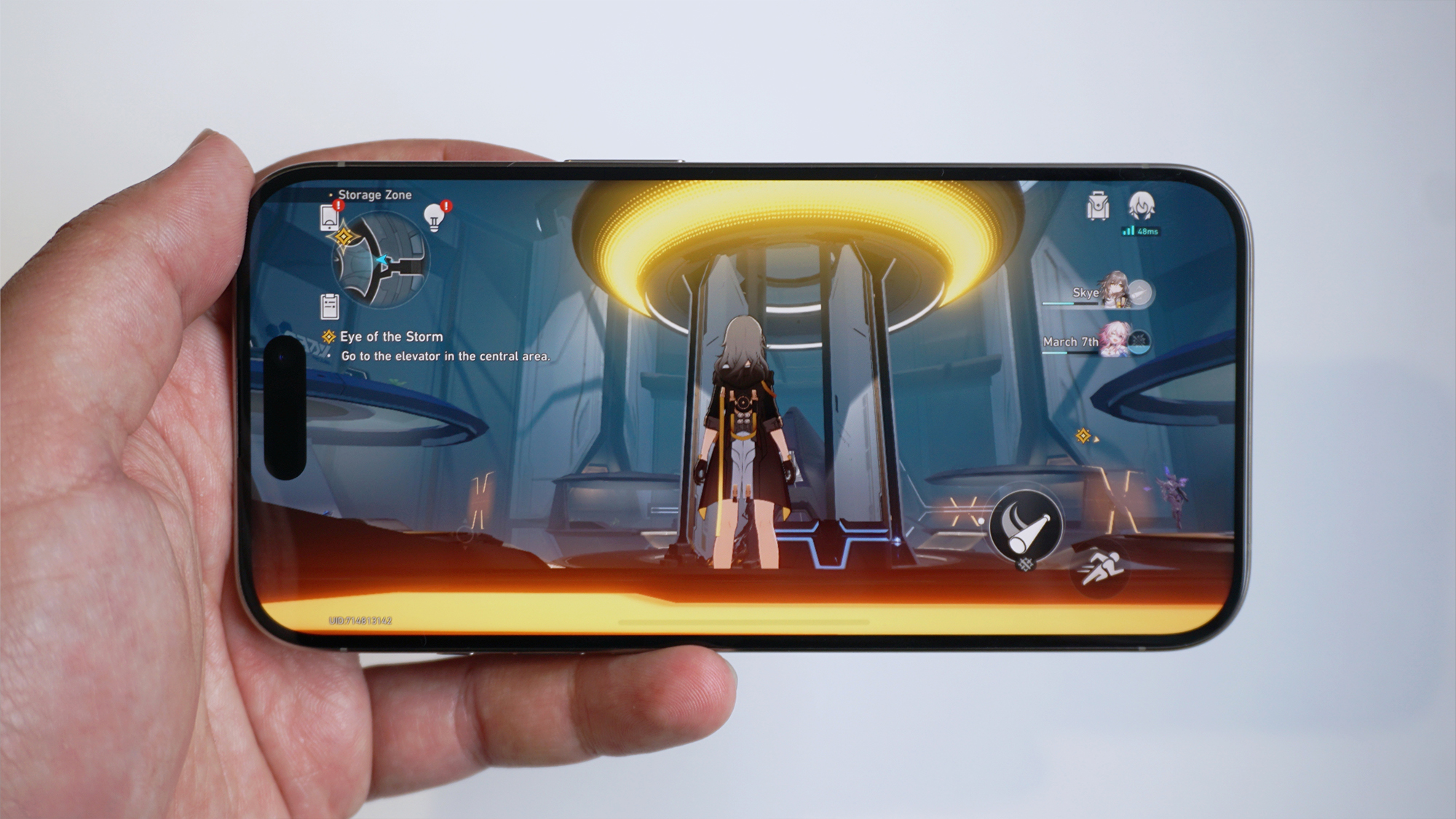
- Debuts Apple A17 Pro chipset
- 8GB RAM
- Class-leading performance
- Known thermal issues at launch
Under the hood, the iPhone 15 Pro is powered by the latest version of Apple’s own silicon – the A17 Pro – which makes it one of the fastest phones (if not the fastest phone) money can buy, right now.
The A17 Pro is more than a simple upgrade to the A16 Bionic still resident on the iPhone 14 Pro line and 2023's iPhone 15 and 15 Plus, though. Inside the A17 Pro is a new CPU, new GPU, and a new 2x-faster Neural Engine, not to mention it runs at a higher clock speed compared to the A16 and uses TSMC's latest 3nm process; designed to help with power and efficiency.
In testing, it out-maneuvers the S23 Ultra's modified Snapdragon 8 Gen 2 with regards to Geekbench 6 CPU scores (although the A16 does too) and actually tops our list of tested phones – alongside the 15 Pro Max, with a multi-core score that surpasses 7,000 (the S23 Ultra scored 5,365, while the Pixel 7 Pro scored 3,386).
Perhaps the most impressive gaming performance came during my briefing with Apple, where the company showcased what it bills as "console-quality games" running on the iPhone 15 Pro's 6.1-inch display at a smooth 30fps. Titles like Resident Evil: Village (coming to the App Store this year, on October 30) and the remastered Resident Evil 4 (coming to the App Store December 31, this year) are apparently ported directly over to iOS, to run on A17 Pro-equipped iPhones.
As for my own gaming experiences, Genshin and Honkai Impact are the some of the most demanding titles I could think to try out during review and, sure enough, during a continuous 30-minute play session, despite the impressive draw distance, motion blur and particle effects such titles serve up, not once did the 15 Pro stutter. Nor did it heat up to any concerning a degree; an issue that select users of all four iPhone 15 models are reporting at launch, unfortunately. Still, it's nice to know this doesn't appear to be a symptom of the A17 Pro and can be addressed with a little additional power management update from Apple.
If the addition of new ProRes at 4K/60fps capture and newfound support for ported console games wasn't a good enough indicator of what the A17 Pro was capable before laying hands on it, real-world usage and in-house benchmarking only hammer the point home further. With so much headroom, I'm excited to see what Apple and developers are able to pull off over the course of the next year, because lines certainly feel like they're beginning to blur here.
- Performance score: 5 / 5
iPhone 15 Pro review: Battery life
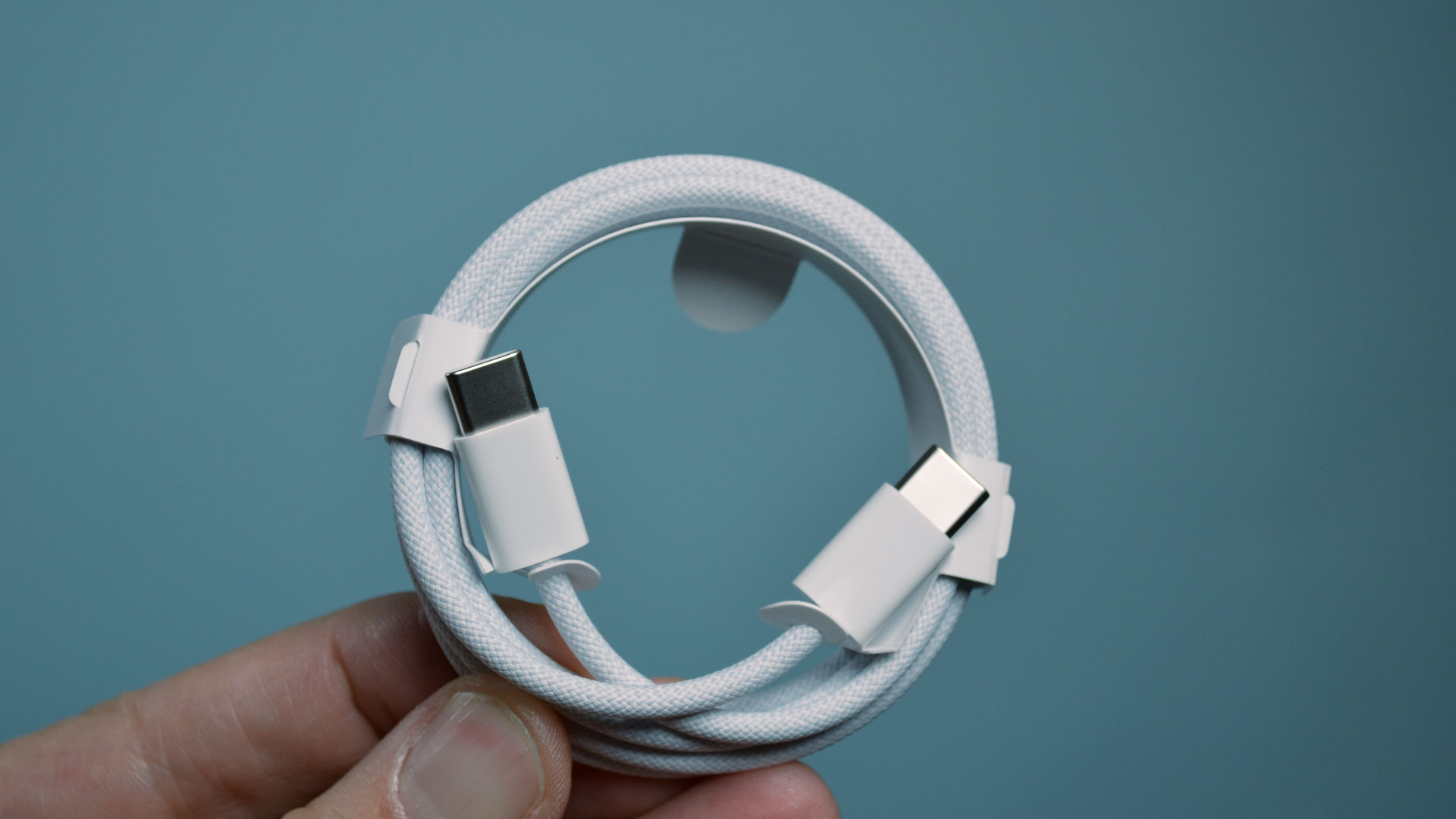
- 3,274mAh battery
- New 80% charge limit feature
- Up to 27W fast charging (same as predecessor)
- Now supports reverse wired charging via USB-C
As is tradition, Apple hasn’t publicly revealed the iPhone 15 Pro’s battery capacity but that hasn't stopped people from uncovering the size of the cells inside all four of the latest iPhone models; with the 15 Pro in possession of a power pack that's fractionally larger than its predecessor's, at 3,274mAh, (up from 3,200mAh).
Apple quotes the same 23 hours of video playback as on the iPhone 14 Pro, which isn't surprising, considering the minute capacity change year-on-year, while charging speeds are unaffected too: up to 27W wired, 11W wirelessly via MagSafe and 7.5W via Qi wireless charging.
My device managed around 5.5 hours of screen-on time per charge, akin to the recent Samsung Galaxy Z Flip 5 (which sports a 3,700mAh battery), which is enough for a comfortable day's use or can carry you through to the following morning, if you're sparing with it. For reference, running Honkai Impact resulted in an average drain of 1%-per-minute of play time, but that's likely one of the most demanding things you'll do with the phone.
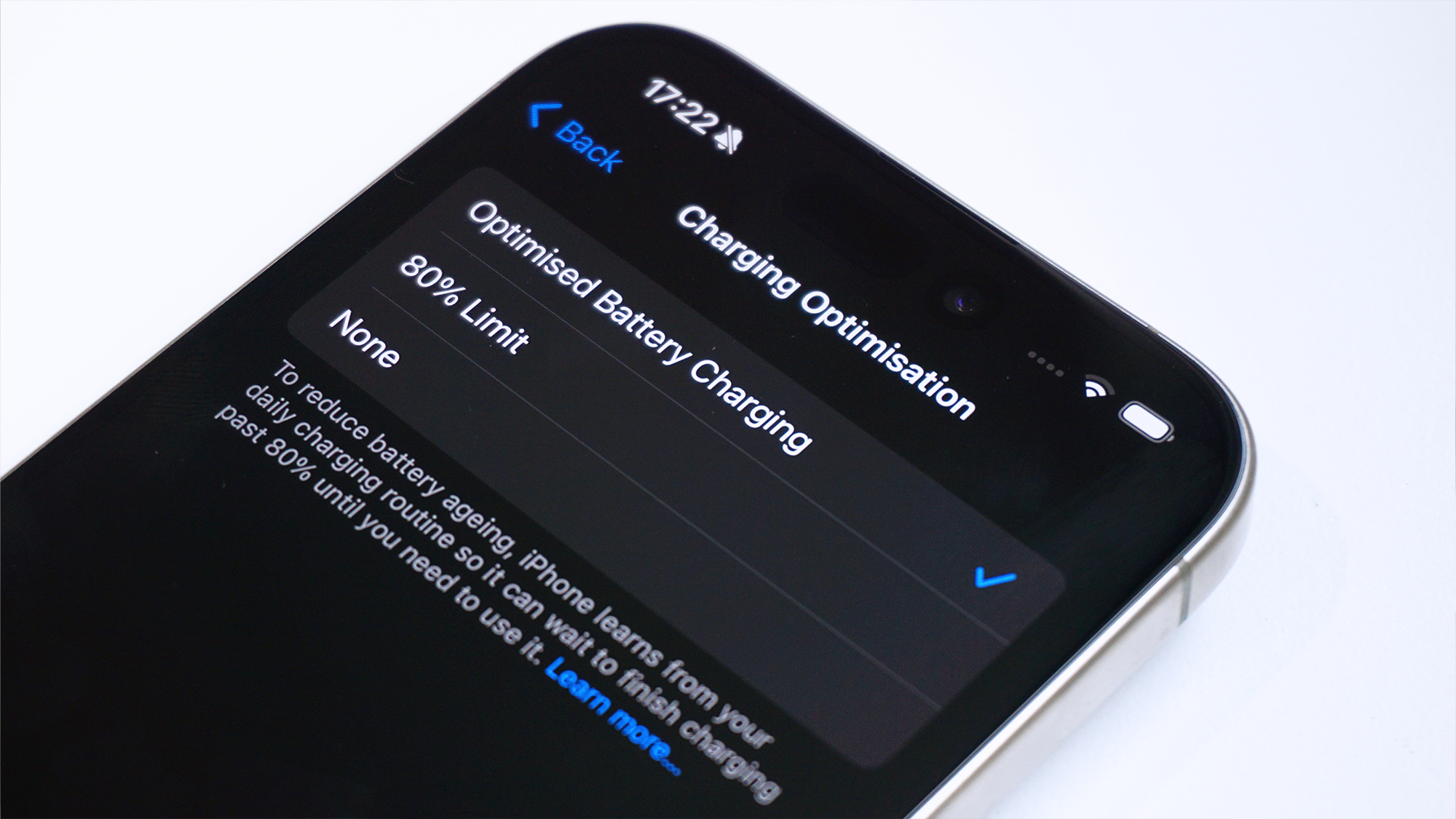
The twist this year is, of course, the switch to USB-C, which for many – both inside and out of Apple's walled garden – adds an extra layer of convenience to the charging experience served up by the 15 line. As well as celebrating with a new braided USB-C to USB-C cable in-box, the 15 Pro now also allows for reverse wired charging via USB-C (at approximately 7.5W, according to Apple), just in time for a new set of AirPods Pro 2 with a USB-C charging case to launch, how fortuitous.
It's a shame the jump in data transfer speeds brought on by the move to USB-C hasn't also been reflected in a change to peak charging speeds, but regardless, real-world recharge times should prove sufficient for most people. In testing, the Pro surpassed 50% charge in 30 minutes (with a full charge taking 1 hour 35 minutes, although the last 30 minutes was spent reaching from 90% to 100%).
If you're the kind of user who keeps the same iPhone for multiple years, the 15 line also introduces a new charging optimization option, that lets you set a new hard ceiling of 80% when charging; designed to prolong long-term battery capacity and health, which is an uncharacteristically transparent move by Apple, in terms of the iPhone's power management, but nonetheless a welcome one.
- Battery score: 4 / 5
Should you buy the iPhone 15 Pro?
| Attributes | Notes | Rating |
|---|---|---|
| Value | While you could argue that the 15 Pro packs in more power for its size, similarly styled rival flagships cost significantly less | 3.5 / 5 |
| Design | The subtle tweak to the frame's shape, the move to lighter titanium and USB-C not to mention the back glass is cheaper and easier to replace. Nice | 4.5 / 5 |
| Display | A great adaptive 120Hz OLED with the best always-on display implementation out there. | 5 / 5 |
| Software | Familiar for long-time iPhone users with some nice quality of life improvements and great long-term update support. | 4.5 / 5 |
| Camera | Sure, there's no 5x optical zoom but that doesn't stop the cameras that are present from being powerful and excellent. | 4.5 / 5 |
| Performance | The 14 Pro series already had a lead on the current Android rivals and the A17 Pro is truly in a league of its own. | 5 / 5 |
| Battery | Perfectly adequate all-day battery life and charging with minor upgrades and room for improvement. | 4 / 5 |
Buy it if...
You want the most powerful phone on the market
iPhones are known for their market-leading power and the iPhone 15 Pro is at the top of the heap right now. Could this be the start of Apple's unorthodox play into mainstream gaming too? Only time will tell.
You want an excellent pocketable cameraphone
Sure, the standard 15 Pro loses out on the 15 Pro Max's headline 5x optical zoom, but its absence doesn't detract from the phone's otherwise superb all-round camera experience in a compact form factor.
You're a professional filmmaker looking for a high-quality compact camera that supports industry standards
Sure, this is one of the more niche reasons to pick up the iPhone 15 Pro but if Apple's willing to spend time marketing the phone's professional video feature set, who am I to ignore its worth.
Don't buy it if...
You're on a tight budget
If you want that Pro-level iPhone polish, expect to pay a premium for it. Sure, the camera's better and performance is unmatched, but against a direct rival – like the Samsung Galaxy S23 – it makes for a significantly more expensive upgrade.
You need exceptional battery life
The iPhone 15 Pro musters acceptable battery life for a phone that can do as much as it can, however, if you're a power user or someone who frequently is away from their charger for extended periods, the iPhone 15 Pro Max or our new battery champ – the iPhone 15 Plus – make for better fits.
You need that telephoto camera
The camera performance from the iPhone 15 Pro is exceptional but just knowing that it loses out on Apple's current best camera system is a little infuriating. If you value the camera over the phone's compact nature, opt for the 15 Pro Max or the Galaxy S23 Ultra instead.
iPhone 15 Pro review: Also consider
The Samsung Galaxy Z Flip 5 is an undeniable triumph but it's still leaves plenty of room for improvement and some alternates don't suffer from such shortfalls. Here are some alternatives to consider.
iPhone 15 Pro Max
Everything the 15 Pro has to offer and more; with a bigger screen, bigger battery and that all-important 5x telephoto snapper. You also get double the base storage but pay a premium for the privilege.
Samsung Galaxy S23
The go-to Android-based alternative to an iPhone is a Samsung and the similarly-sized standard Galaxy S23 sports flagship performance and ecosystem integration in a fashion not dissimilar to the 15 Pro.
Sony Xperia 1 V
If you're looking for a phone with a sideline in professional video that isn't the iPhone 15 Pro, Sony's Xperia 1 V fits the bill, with innovative camera hardware and industry-grade capture tools on hand.
| iPhone 15 Pro Max | Samsung Galaxy S23 | Sony Xperia 1 V | |
|---|---|---|---|
| Price (at launch): | From $1,199.99 / £1,199 / AU$2,199 | From $799.99 / £849 / AU$1,349 | From $1,399 / £1,299 / AU$2,099 |
| Dimensions: | 159.9 x 76.7 x 8.25mm | 70.86 x 146.3 x 7.62mm | 165 × 71 × 8.3mm |
| Weight: | 221g | 168g | 187g |
| OS (at launch): | iOS 17 | Android 13 | Android 13 |
| Display: | 6.7-inch (2796 x 1290) adaptive 120Hz Super Retina XDR OLED | 6.1-inch 19.5:9 Full HD+ 48Hz - 120Hz AMOLED | 6.5-inch 21:9 4K (3840x1644) 120Hz OLED |
| Chipset: | Apple A17 Pro | Snapdragon 8 Gen 2 for Galaxy | Snapdragon 8 Gen 2 |
| RAM: | 8GB (LPDDR5) | 8GB (LPDDR5X) | 12GB (LPDDR5X) |
| Storage: | 256GB / 512GB / 1TB (NVMe) | 128GB (UFS 3.1) / 256GB (UFS 4.0) | 256GB / 512GB (UFS 4.0) + microSD (up to 1TB) |
| Rear Cameras: | 48MP main, 12MP ultra-wide, 12MP 5x telephoto | 50MP wide, 12MP ultra-wide, 10MP 3x telephoto | 52MP (48MP effective) wide, 12MP ultra-wide, 12MP 3.5x to 5.2x variable telephoto |
| Front camera: | 12MP | 12MP | 12MP |
| Battery: | 4,422mAh + 27W wired charging | 3,900mAh + 25W wired charging | 5,000mAh + 30W wired charging |
How I tested the iPhone 15 Pro
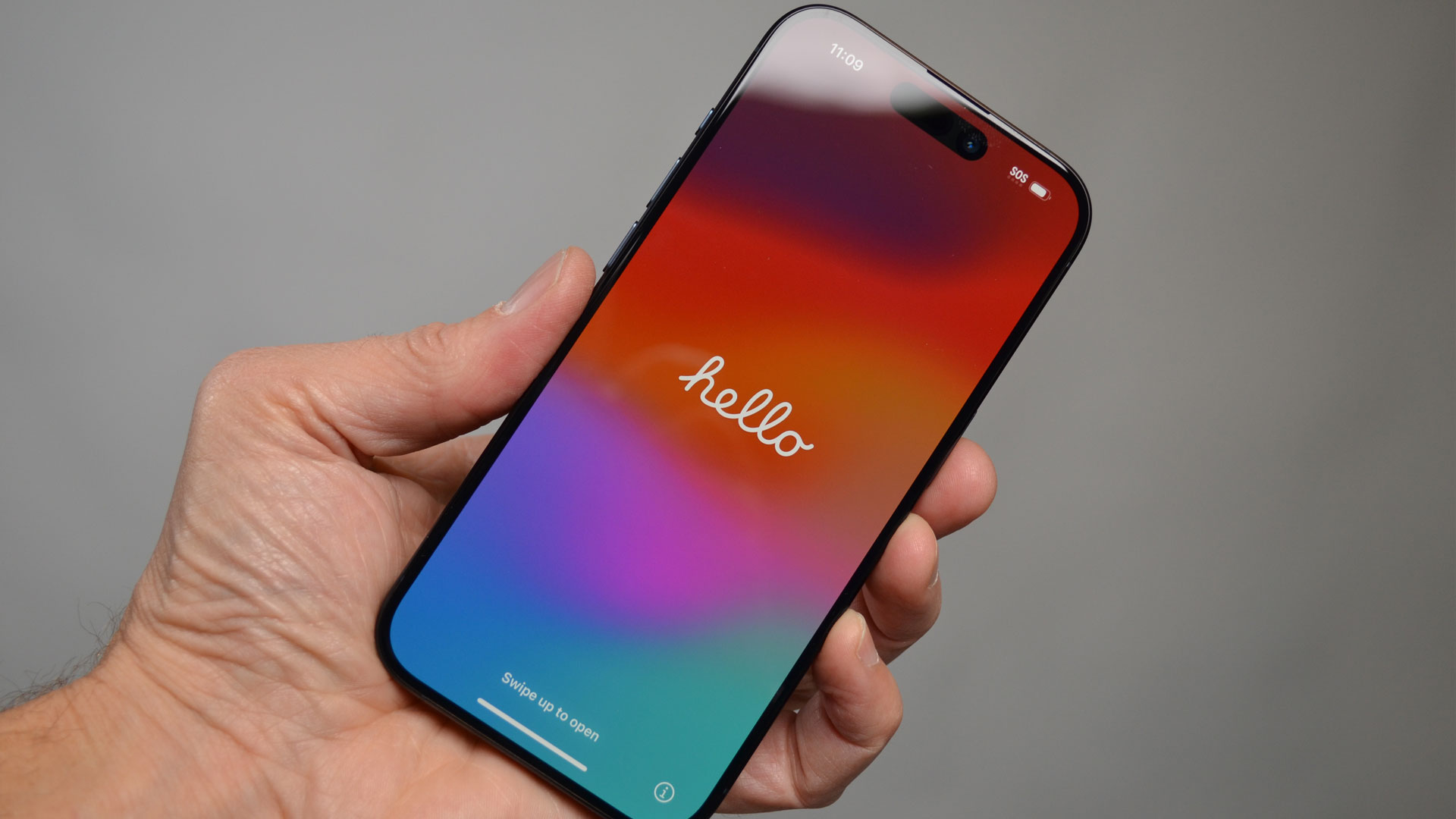
- Review test period = 1.5 week
- Testing included = Everyday usage w/ web browsing, social media, photography, video calling, gaming, streaming video, music playback
- Tools used = Geekbench 6, Geekbench ML, GFXBench, native iOS stats, Apple 30W USB-C MacBook Air charger
Following the launch of the iPhone 15 line, I was invited to Apple's Battersea HQ in London to be taken through the key new features of all four iPhone 15 models, with a dedicated photography studio demo for the iPhone 15 Pro/15 Pro Max, before taking review samples away to test for this review and beyond.
After a week and a half living with the iPhone 15 Pro and additional insights from TechRadar US Editor in Chief, Lance Ulanoff – who had a device of his own – I assembled this review, focusing on all the key aspects that potential buyers would likely want to know about when it comes to living with this device.
I also tested battery life and recharge times, used the camera in a myriad of common scenarios and kept notable rivals on-hand – like the Pixel 7 Pro and Samsung Galaxy S23 Ultra – for direct comparison. I also conducted benchmarks with publicly available tools like Geekbench 6 (where the 15 Pro accrued a multi-core score average – across three runs – or 7,116), Geekbench ML to test the phone's new NPU (it scored 3,646, where last year's iPhone 14 Pro Max scored 3,209) and GFXBench to better assess graphical capabilities – although, despite the phone's 120Hz display, iOS appears to cap frame rate at 60fps, which the 15 Pro was able to reach in almost every test.
As for charging, as Apple doesn't include a power adapter in box, I used an official 30W USB-C charger (usually used to power my M1 MacBook Air) to reach the phone's peak charging speed of 27W.
As a reviewer with 12 years experience and having reviewed numerous iPhones in my career, I felt confident assessing and scoring the iPhone 15 Pro relative to other iPhone models, as well as the wider smartphone market in which it competes.
First reviewed September 2023

Alex joined as TechRadar's Senior Phones Editor in June 2022, but brings over a decade's worth of experience to the role, with an expertise in smartphones, tablets and wearables. He's covered keynotes hosted by the biggest brands and attended the launches for some of the most influential mobile products of the last few years. His experience was amassed at some of the most reputable consumer technology publications out there, including GSMArena, TechAdvisor and Trusted Reviews.
